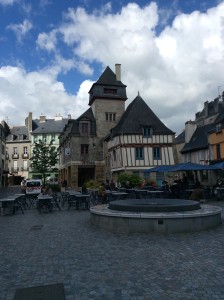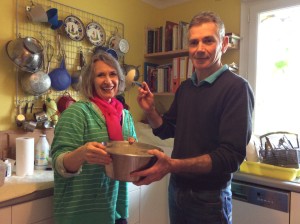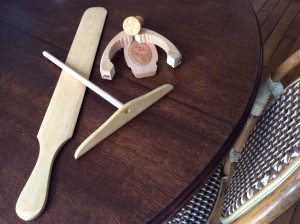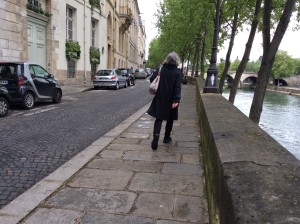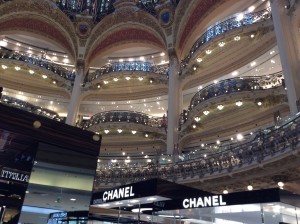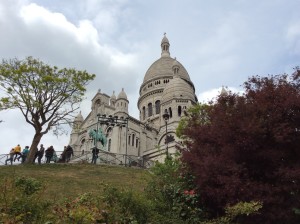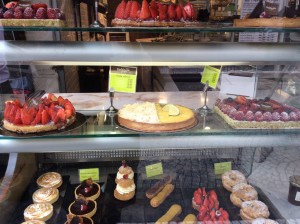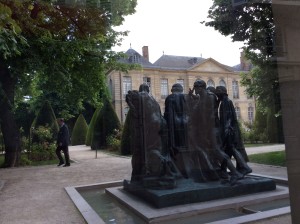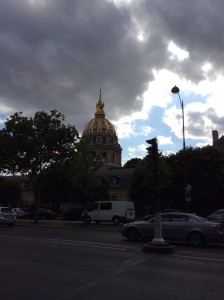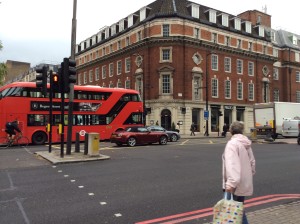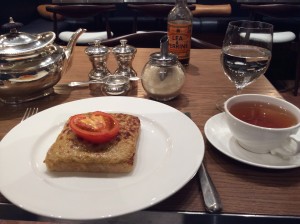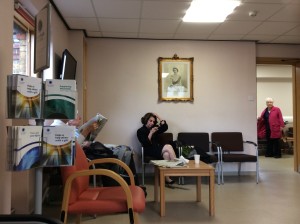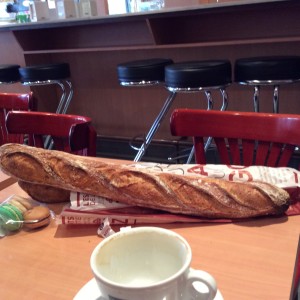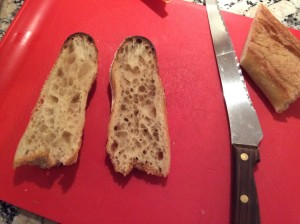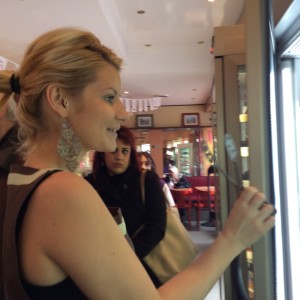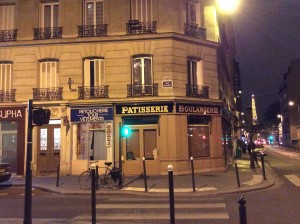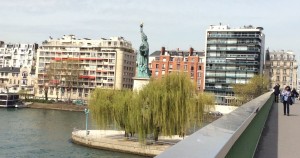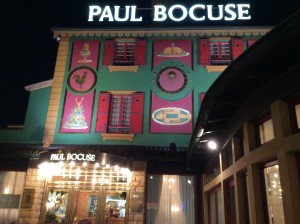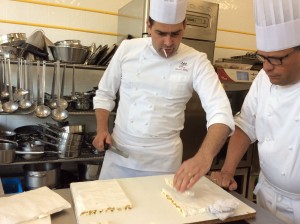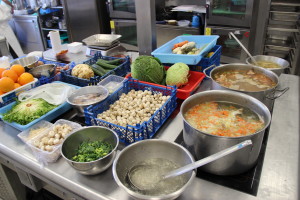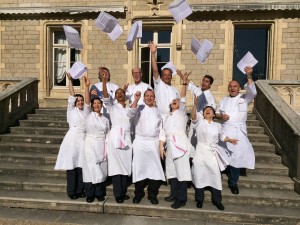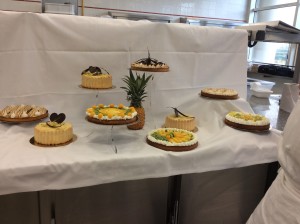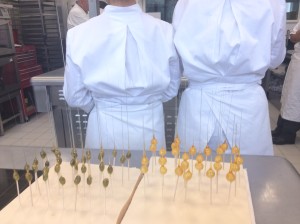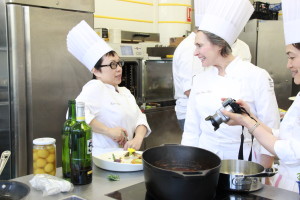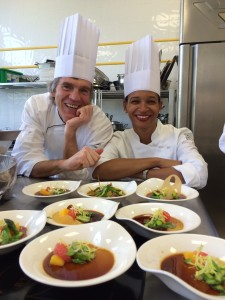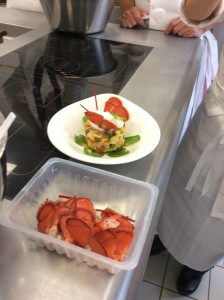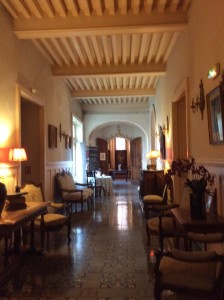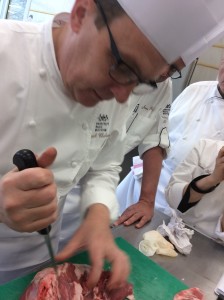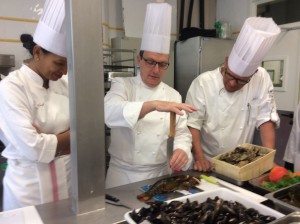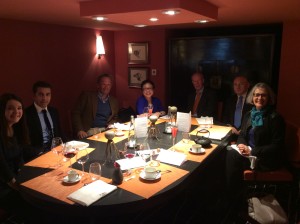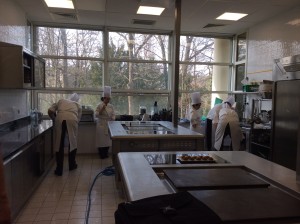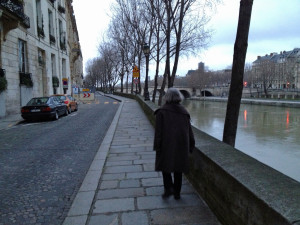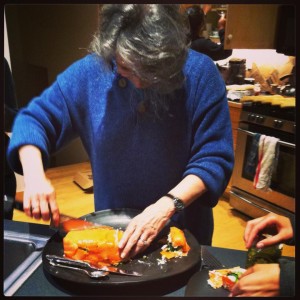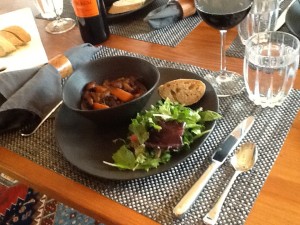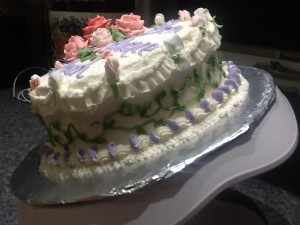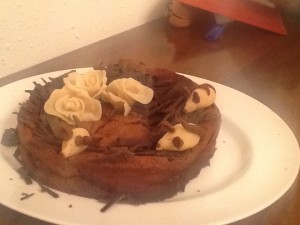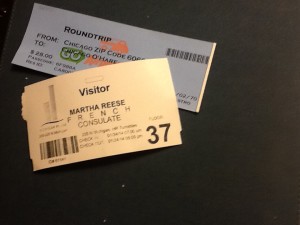The sabbatical has been great. Thank you for participating with me. Now we’re heading home, rested, ready to be back with our beloved friends and to get to work. My new book (not an Unbinding one, something very different!) is coming together in my head. So I’m going to go quiet for a while to write. So grateful for each one of you who has been part of my sabbatical. I’m excited about Next Steps!
Cooking in Brittany
I’m on the train, traveling back to Paris through the gorgeous Breton (Brittany) countryside (green, green, hilly). It’s a cloudless day.
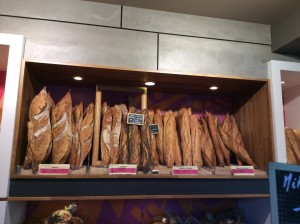
MY baguette was from the far right – ‘Pain de patron.” The little local bakery appeared on a list of the 111 best patisseries in France. Here are their eclairs.
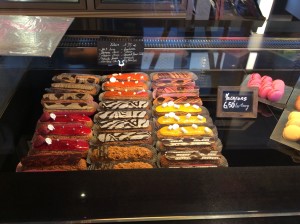
The Plomblin bakery’s eclairs. This is a town of about 4,000 – sprawling through the aid countryside. these eclairs would leave most Paris bakeries in the dust.
I’m munching in a leisurely way on a ham sandwich made with salt-chipped, Breton “flour de sel” butter and the most exquisite multi-grain baguette composed of what my friend Patty Feld would call bark and twigs and crunchy bits. Life is great. I’ll probably have to search out a bottle of water from the bar pretty soon. I have loved the last week with my friend Judy and her French husband Marcel. Judy and I went to high scool together and she has been one of the inspirations and cheerleaders for my learning French. She’s an international dealer Quimper pottery (www.BrittanyByways.com and www.thequimpercollection.com). I sent her an e-mail six months ago and told her my plans for my trip to France. She whipped back a response three days later announcing that she had it all arranged:
- I was coming to Brittany for a week to stay with her and Marcel.
- I was going to have a lesson in making kouign amann (a round of something like croissant dough layered with a horiffic amount of butter and sugar – it caramelizes) with the head patissier in the Quimper bakery,
- I would work a day in the loveliest restaurant in Quimper, The Priore (www.le-prieure.fr),
- and Michel, their neighbor who makes traditional, Breton buckwheat crepes in Quimper would give me an evening lesson. It was all arranged.
Didn’t seem to be any point of arguing, and it sounded great so that’s what I did. My only contribution to the plan was to ensure that my trip to cook with the hot shots in Brittany was at the END of the trip so that I could minimize humiliation by (a) my cooking, and (b) my French. Last Sunday, I headed to the Montparnasse station to catch the train to Bretagne. Two hours before that, I had put other dear high school friends onto a train to go horseback riding in some wilds I haven’t seen between Paris and Burgundy. Ellen and Mary and I had had two glorious days visiting the Rodin museum, the Paris islands, the outside of Notre Dame (too crowded), cooking a dinner here, and eating in the most wonderful restaurant so far, Stephane Martin, a brilliant young chef who’s cooking in the 15th arrondissement, 67 rue des Entrepreneurs (www.StephaneMartin.com). If you’re in Paris, bag Napoleon’s tomb – get to Stephane Martin. Brittany is remote – it’s a four and a half hour fast train ride from Paris to the northwest.

Brittany’s green. (It’s the NW part of France, called “Bretagne” in French, and it’s why after the Norman Conquest (1066), the land to the north is called “Great Britain.”)
You know about Normandy, if only because of the Normandy beaches and D-Day. Normany is famous for cows and Camembert and apples and crème and Calvados. Brittany is famous for butter and carmel and strawberries and oysters and fishing villages and langoustines and Quimper pottery. If you’ve had salty carmel ice cream lately, or pieces of rocky salt on a carmel, it’s an import from Brittany. It took 7 hours of train riding to get there until fairly recently. It’s far, wild and charming. It’s not the Eifel Tower. It’s rural.
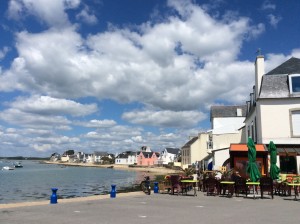
Here’s a little fishing village 5 miles from Judy and Marcell’s house. We ate lunch there. The pink house was built for fishermen to hang out in during the winter (wholesome activities, not so much with the drinking).
The weather is like Seattle’s – humid, an acidic-soiled microclimate that’s mild in the winter and cool in the summer. There are banana palms, cacti, fig trees, fishing villages with green and blue shutters, boats all over the place and loads of tourists all summer. It’s quiet now. The professional cooking deals that Judy had arranged scared the andouillete out of me. This is very French, high level cooking, way out of my league, only available because Judy has been in business here for about 20 years. She knows everyone and they love her. I don’t like fumbling about. I really didn’t want to fumble around on Judy’s ticket. Eesch. One of my friends interviews for jobs well, and worries that she may be an articulate incompetent. I get it. But I sucked it up and stepped into:
Challenge #1, The Bakery and kouign amann, on Monday morning (www.biscuiteriedequimper.com). No pictures of any of this stuff. This isn’t personal. It’s business. You can’t act like a tourist on a job. Two guys were whipping huge baking sheets of dough onto stainless steel counters with, oh horrors, an enormous picture window so the busloads of tourist clients could see exactly what I was doing. They gave me a white shirt with too-large buttons that fastened at glacial speed, and an enormous apron.
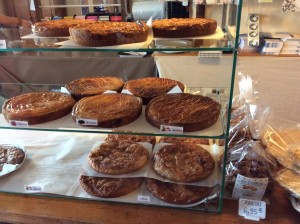
Breton butter cake (“Kuighn amman”). No action shots, but the middle row is part of the 100 left from yesterday’s baking.
The head baker gestured to the table next to him, handed me a massive hunk of fragile dough, a cold square of about 3 pounds of butter and a thick, meter-long wooden rolling pin. He picked up his pin and we started, with me trying to mimic his effortless motions as closely as possible. (I felt exactly like that time I decided to start ballet in law school. The teacher had been a principal dancer with the NYC Ballet, under Ballanchine. I was awed, and behind the curve.) I tapped the top of the dough, tapped the bottom, stretched out flaps on the sides, folded them in, rolled the whole deal out to a meter and a half, and a meter wide, maybe, then folded it like a letter, flicked on flour. (At least I can do the folding and the flour flipping well – that’s one of the deals that separates les professionels from les amateurs, I’m here to tell you.) But the real breaking point hits at stage #4. You roll out the now 750+ layers of dough and butter and sugar to two meters long and a meter wide (3+ feet x 6+ feet). I could barely reach the back of the stainless steel table, but did it without ”dechire”ing (tearing) the dough. That was a miracle. A hole in the dough would have been “une catastrophe.” We did it – went through the whole six step process four times and then he gave me a taste of a finished one. as I struggled to UNDO the buttons quickly, which were still larger than the holes. The kouign amann was staggeringly good, if you like crispy pastry, butter and crispy carmelized sugar. I do. It was a Meg Ryan/Billy Crystal-in-the-diner moment, I’m here to tell you. But I was in France. I was trying not to act like an amateur, so I was subtle and didn’t embarrass anyone. When we do the closest approximation of kouign amann of which I’m capable at our house in MN, I’m thinking some of you may not be capable of pulling off my sophisticated restraint. I’m putting $5 on Karen who-shall-remain-last–nameless moaning and pounding on the table.
Challenge #2, Le Priore (the Priory), Tuesday all day: It’s a gorgeous place – the12th century priory (de-priory-ized during the French revolution – a bad time for the church in France – then used as a military depot, then restored during the late 19th century, then further restored and used as the loveliest restaurant in Quimper fairly recently. The last party Judy arranged there was for the American Ambassador and visiting dignitaries. Restaurants are usually closed on Monday, so Tuesday is really the first day of the work week for them. Fish arrive, they make stocks from langoustine shells, they organize and get things underway for the week on Tuesdays. Judy and I went in through the back door of Le Prieure (www.le-prieure.fr) . It was more disconcerting than walking in the front. The sous-chef (the chef in charge of the kitchen, the #2 guy, not the planning/oversight chef), smiled reassuringly at my mommy surrogate, gently pried my hand from her arm, showed me the locker room where I could stash my raincoat and pink My Little Pony lunch box (okay, I’m getting hyperbolic here), didn’t introduce me to the other kids, but did give me an apron to wear over my plain black clothes, handed me a knife and something like 150 of the biggest, most gorgeous langoustines I’d ever seen. They were alive, iced, and thank heavens I, child of Ohio, knew all about twisting off their little torsos from their tails. I got to it. I murdered all of them. I know I’m going to come back as a grasshopper in my next life. Or a langoustine. The young guy next to me (Christophe) showed me how they wanted them shelled. You pinch the shells together on the back (“tack, tack”), then delicately pull off each shell segment except the last two and the tail. Okay, I could do that. The shells poke your hands, but I’m fast. And Christophe, a sweetheart, kept handing me spoons of things to taste – fish tartare with lime, smoked Norwegian salmon. Total sweetheart.
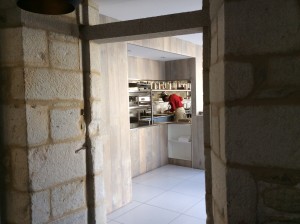
The only photo I took, as I was leaving – here’s Christophe. If he’d been plating, his head would have been 12″ lower.
All this time, waiters and the chef de cuisine and other kitchen help arrived, held out their hands to shake (I offered a wrist, not wanting to slime them with my gooey, seafooded hands. They murmured “bonjour,” shook my wrist, kissed me on both cheeks, then told me their names. I smiled, said, “Marte,” and continued shelling crustaceans, which I lined up in military precision in a big metal pan. Other than the one female langoustine with a HUGE roe sack that disintegrated between my fingers, it went well. I pointed my humiliating failure out to the sous chef when he came by (there was no checking to see that I was doing things well – they just told me what to do and disappeared), he said, “pas de probreme,” and chucked it in with the others. I said, “Pas de problem ? C’etait une catastrophe !” He laughed and bolted. I finished.
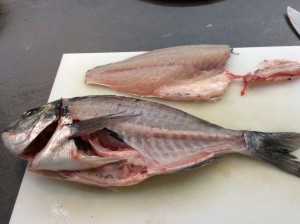
I filleted this with six cuts per side. I’m proud. I don’t need to hang my head in shame before the numerous fisherpeople of Minnesota.
He waved me toward a pile of dorade (lovely, medium sized fish – “dolphins” in English, but not the mammals). A huge pile of dorade, something like 60 of them and asked me whether I wanted to fillet them. Now the secret is that I CAN fillet dorade. I learned how here, since Russ does the fish in our family. The first time I filleted a fish at L’Ecole Alain Ducasse, the chef inquired politely if I were making tartare. But by the third one, I had nailed it. So the chef and I tackled the dorade. We fell into a rhythm. He filled them, I deboned them with lightening speed. You do it by feel. We whipped through the enormous piles of dorade, then I finished and did everything on the huge, slithery cod fish, but only 3 of those. Then I washed two huge sacks of mussels – 5 kilos/11 pounds each – and we had lunch before the service. The cooks and the waiters were all kids in their 20s, except for the chef. Christophe and I had progressed from “vous” to “tu” (I was thrilled that he wasn’t calling me “madam,” but was telling me what to do as if I could do it. Otherwise, no one had talked with me all morning (except for (“pardon,” “chaud” [hot], nods and all the kissing), so I’d kept my head down, smiled occasionally and worked. Lunch was simple and absolutely delicious – zucchini and the loveliest roast chicken you’ve ever tasted. I asked later – Christophe had made it. Here’s the recipe. (1) get a bunch of French chicken legs and thighs (unseparated). Put on onion, salt, pepper, olive oil, garlic and un petit peu de beurre (“a little bit of butter,” and you have to say that with a French accent or it doesn’t brown correctly). You probably brown it first in the butter, then put it in the oven at 180 degrees (about 370 F) for about 30 minutes. It has to be a French chicken, which are more chickeny than ours, as Julia Child says. Nobody talked to me, so I just smiled, ate quickly and we all raced back to work.
They were now ready for the lunch service – show time. I gave serious thought to hanging myself up on a corner hook by my apron strings to be out of the way. It was like being backstage in a play opening night without having attended rehearsals. No quiet corner appeared. The sous chef gestured to me as he started to unstop the huge sink. French sinks don’t have drain baskets – anything thrown into them either plugs up the drain, or is stopped by four little crossbars and plugs up the sink. Six gallons of scaly, scary gray water shimmered in that sink. The cooking chef fished his hand down to find the drain and told me he’d explain what he wanted me to do as soon as he fixed this. “Chef, go away and cook. I’m highly skilled in the exact technique for doing this.” Turned out I’d just flipped the magic switch. Ten minutes of fishing fish scales and guts out of opaque liquid with bare hands and I was part of the team. A slightly moody young cook ran past, shifted the trash can to right next to me and grinned. I helped people do things, then I got to make 80 cheese-and-leek filled chou pastry hors d’oeuvres with tiny pastry hats. Fairly snappy pastry bag and balancing work. And at 2:00 everyone left until 6:00. The executive chef had left it up in the air as to how long I was supposed to stay. They asked if I wanted to come back after lunch. Score! I asked if they needed me, because I really didn’t want to be in the way of “le service” [the dinner service], and they said, no, I would be useful. Yes! Invisible high five.
I walked around Quimper for four hours. I explored the medieval town, bought some macarons from the pastry shop of a MOF (the best artisan in France award). It’s part of my education to taste things. I walked by the river. I walked up hills.
I sat in the cathedral for a while, strolled through the medievally-inspired Priory garden behind the restaurant, across from the Quimper faience museum (very fun), then went back to work. It was great. We prepared a huge buffet for 50 – millions of hors d’ouvres that Christophe and I arranged on platters, I stuffed puff pastry vol-au-vents with mushroom duxelles, toped them with an elegant triangle of foie gras, heated them and garnished with cilantro. I spun into the rushing dance down the narrow spaces between tables, carrying stuff back and forth from the specific places in the huge walk-in refrigerator room. I covered platters with film (plastic wrap. FRENCH plastic wrap that has no cutter strip on the box, you have to find a knife and try not to tangle it. It’s easier to bone the fish. But they let me onto the team, and I watched and when things calmed down, asked questions and helped different people and suggested platter arrangements. They can really, really cook. I learned ways to plate sausages decoratively, how to cook riz de veau (veal brain and it’s actually amazingly good). You cook it just like sole meuniere – brown it, then tilt the frying pan over a roaring flame and flip spoonsful of boiling butter over it. I earned an “impeccable” from Christophe, over a plating suggestions to keep the darned chou pastry appetizers from rolling all over the place. That may be the height of my career. He’s young, but the guy does the most gorgeous plating you’ve ever seen. He should teach when he’s older – he’s gifted. I also hope he started standing up straight when he’s working rather than leaning over nearly double. His 50 year old back would thank him.
They started making jokes with me. The young riz de veau guy who cooks well and moved the trash can for me (probably is the one who plugged up the sink), rushed over to me, grinning, as I shelled 20 pounds of cooked mussels – held up a beautiful, white-tipped, elongated French radish (pronounced, “rad-ee”) and said, “Marte, are you rad-ee??” It was a joke! Mikey likes it! Christophe created a particularly beautiful plate. I ventured my first English, grinning, “Nice!” They asked what it meant. I made the French sideways hand shake as if you’re flicking water off the ends of your fingers (it’s along the lines of, “wow, will you take a load of that – pretty snappy.”) So “nice” became the big word of the evening when anyone had a moment to talk. We worked on high fives before I went home that night. Someone probably told them to be nice to their visiting aunt that morning. They did it. Then they let me into the family. So if you’re ever in Quimper. THAT’s the place to go for an exquisite meal. Le Priore.
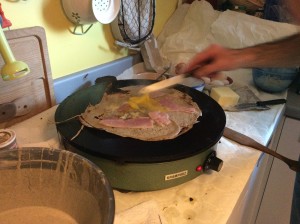
Making a crepe (a “galette,” the Breton name), made entirely with buckwheat. See how thin it is? This one has ham and egg.
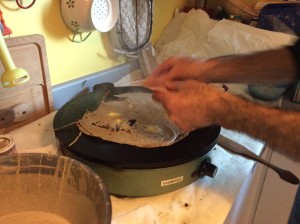 Challenge #3: the Great Breton Crepe Evening Wednesday. It was GREAT. Michel learned tho make crepes from his grandparents. His grandfather made his wooden spatula for him. You’ll see the pictures – what you can’t see is that these are the best crepes in the world. They’re way better than the Parisian ones made with white flour. These are buckwheat. I had them in Lyon last year and that one was no where NEAR as good as Michel’s. I’ve talked too long, so I’ll summarize and you look at the pictures. 1. You mix the batter by hand for a long time. I mean WITH your hand, not a spoon. It’s a little like splashing in mud, but loads of aeration. It takes a while – 3 eggs into a well of 500 grams of buckwheat flour, then add trickles of liquid. He eventually incorporated not quite a quart of milk (less than a liter bottle), 2 teaspoons of fleur de sel (that’s really approximate – it was bits in the hand 4 times), and maybe ½ – ¾ cup of water. You sweep tiny bits of flour from the edges of the egg mixture so that you don’t get lumps, then pull up streams of batter 18″ over the surface and let it cascade back into the bowl to aerate it. Then you cook them over a 240 degree centigrade (455 degrees Farenheit) griddle. The test one (enough salt? Thin enough batter to have little holes through which you can see the griddle?) is “pour le chat.” [for the cat]. Just like pancakes.
Challenge #3: the Great Breton Crepe Evening Wednesday. It was GREAT. Michel learned tho make crepes from his grandparents. His grandfather made his wooden spatula for him. You’ll see the pictures – what you can’t see is that these are the best crepes in the world. They’re way better than the Parisian ones made with white flour. These are buckwheat. I had them in Lyon last year and that one was no where NEAR as good as Michel’s. I’ve talked too long, so I’ll summarize and you look at the pictures. 1. You mix the batter by hand for a long time. I mean WITH your hand, not a spoon. It’s a little like splashing in mud, but loads of aeration. It takes a while – 3 eggs into a well of 500 grams of buckwheat flour, then add trickles of liquid. He eventually incorporated not quite a quart of milk (less than a liter bottle), 2 teaspoons of fleur de sel (that’s really approximate – it was bits in the hand 4 times), and maybe ½ – ¾ cup of water. You sweep tiny bits of flour from the edges of the egg mixture so that you don’t get lumps, then pull up streams of batter 18″ over the surface and let it cascade back into the bowl to aerate it. Then you cook them over a 240 degree centigrade (455 degrees Farenheit) griddle. The test one (enough salt? Thin enough batter to have little holes through which you can see the griddle?) is “pour le chat.” [for the cat]. Just like pancakes.
2. They cook quite quickly (a minute and a half to two minutes or so if it’s just plain – this doesn’t count cooking fillings). You can eat them (“nature,” or naturally – strawberries without cream or sugar – just plain, are “nature”), but in Brittany, “nature” means with butter spread on the non-presentation side, which is how they get really crispy. The more butter, the crispier. I limited myself to about 2 teaspoons of butter on my nature crepe. Others are not so restrained. In more modern times, people have started adding other things. A “complet” has ham and egg and gruyere-type cheese. You can have the egg sort of scrambled, or sunny side up, and it’s cooked right on the lower side of the crepe.
3. Everyone eats exactly what they want. Immediately. You don’t wait, you just get your crepe, run to the table and expire with the exquisiteness of it all.
4. Meal crepes first, then dessert crepes. You could do sautéed apples with salty carmel sauce, chocolate sauce, ice cream inside, whatever.
5. The tricky part is spreading the batter. There’s a little flat paddle and people who know what they’re doing spread it very thinly – with little holes where the griddle shows throough – it is crispier that way. But the trick is only pulling the batter. The REAL trick I discovered after doing a few is to put the batter on the griddle off center. I’m right handed – I ladled on the one ladle-full of batter onto the upper left part of the griddle with my left hand. Then I swooped the paddle to the right and down in a half-circle, then I swooped the paddle to the left and down. Then you fix the holes. This is at high speed, because the thing is setting up and hardening as milliseconds pass. ![]()
Judy and I went to the wood guy at the market yesterday (Thursday) and I bought the turner and batter spreader. I fell in love with hand-carved wooden butter molds, so I got one of them, and two butter stamps. We are going to have fun parties when I get home! The galette instruments are made of boxwood, like the pegs of daughter Elizabeth’s violin. I think that’s a good omen. I’ll be practicing. Michel was playing the Mendelsson concerto with the ones his grandfather made for him.
Judy and Marcel – thank you more than I can express!
Wandering around Paris
Today has spit rain, rained during sunshine and sparkled brilliantly blue with white clouds. And I spent 6 and a half hours walking in it (minus 20 minutes to eat felafels and 20 minutes to sit in St. Eustache church of the gothic gloriosity. Even with stopping and trying to find my favorite sunscreen (made in Paris, advertised in France, but not for sale here, at least in the 5 stores I tried), my little trek google mapped as 12+ miles. Thought you might like some pics.
I started at home in the 15th arrondissement and started my fruitless search for my sunscreen. They didn’t have any in the Sephora in my neighborhood, so I went to the Galleries Lafayette, the Very Fancy Parisian department store by the Paris Opera house. They didn’t have my sunscreen either.
I was leaving the store and almost stumbled over 8 women friends giggling and whipping out their iPhones to take pictures over my left shoulder. I couldn’t get my iPad out quickly enough to get the photo of THEM, but here’s what they were photographing. Vogue-readers’ True Paris!
I wandered through southern Montmartre, then further north toward Sacre Coeur.
I’m wasn’t doing so many tourist attractions like this one (Sacre Coeur, Basilica of the Sacred Heart, which is beautiful, but which I spent quite a bit of time in a couple of weeks ago. It’s also a wicked climb up what seem like 40 flights of stone steps. I just got to the bottom, looked up and smiled at it. You don’t need to conquer the same mountain four times. That can be merely derivative.

Saint-Gervaise. Tryna and I visited last week, but just walked by yesterday – it houses the 1975 order Communities of Jerusalem. It’s an absolutely beautiful church very near the Louvre on the north bank of the river.
Today, I wandered and window shopped (for me, that’s not clothes, it’s my art forms: food and churches and people). I wandered north and east, looking. Not talking, just listening to conversations going on around me, and taking in the feel of this part of the city. Paris’ sections are wildly different. I’ve spent time in many of the neighborhoods this trip. I take classes in some, walk through others, go to others in search of something. Wow. I just compiled the list of the arrondissements in which I’ve been in the last month: 1st, 2nd, 3d, 4th, 5th, 6th, 7th, 8th, 9th 14th, 15th (where I live), 16th, 18th and 20th.
Lots of people – residents, writers about Paris and foreigners living here – say that Parisians don’t know other areas of the city. They don’t even know their OWN neighborhood. I’m starting to buy it. I’ve asked 10-20 people for a street name which turns out to be within 3 blocks of their business or where they’re walking with a grocery trolley. They don’t know where it is. And this has happened 5 or 6 times. On the days when the iPad’s goofy, I now just wander until I get there, or enjoy the charm of having 20 interrogative and very polite conversations to work on my French.
The first class at L’Ecole Lenotre should have been simple. The web site gave the address with no map. But how hard can it be to find 10 Ave. de la Champs Elysee? I still gave myself half an hour to get lost. I was only 15 minutes late because #10 is not between 8 and 12 Ave. de la Champs Elysee. It’s 4 blocks to the southeast of there, tucked back into a park. Go figure. THAT was a day for adrenaline. I ended up going back to two of the most helpful and thin people (who didn’t know where Lenotre was EITHER, but were very nice) and giving them the very elegant tartes aux chocolate avec canelle that I made during the class.
But, like I said, yesterday had no stress. I didn’t have to find ANYTHING. I wasn’t going to a new school under time pressure. I just wandered, and thought that if I ended up near Les Halles, the site of the old food market of Paris, I’d buy some pectin NH (the strong, professional pectin for clear fruit tops of tartes) and maybe stop at Dehellerin, Julia Child’s and my favorite cooking store with its old-hardware-store feel, and see if they’d gotten in another set of square stainless nesting cutters. Do you have any IDEA what it is for a Type A like me to just wander around? That’s why I’m documenting it – it’s my first day of aimlessness in two months over here. We won’t talk about the decades before that.
This was pretty much my scenery for an hour:
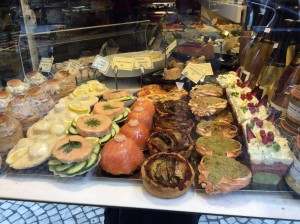
These aren’t pastries, they are made from sea food – salmon terrines and little crab things. The green ones next to far right looked just like little crabs in pink shells. Aren’t they fun?
Then I found myself in Les Halles. And I stopped and got a taboule salad and some felafel’s at a Libanese restaurant. I fell in love with felafels that my friend Tammy and I shared one a couple of weeks ago in the Jewish Quarter (I’d only had bad Indianapolis felafels before, but these turned me right around. They were EXQUISITE.) 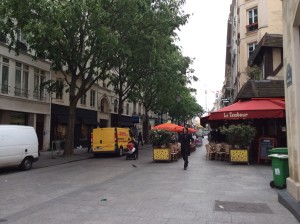 I looked them up on line and discovered that the original felafels are middle eastern and made from fava beans, but have become really popular fast food in Jerusalem. However, many Jews have an enzyme deficiency of G6PD, so fava beans can precipitate a life-threatening reaction. So in Jerusalem felafels are made with chickpeas. I decided not just to go back to the place Tammy took me, where I’d fallen in love with the things, but to eat my first fava bean felafels and do a taste comparison. This is, after all, an educational cooking sabbatical. I can’t just eat what I KNOW I love. I have to Branch Out. But, as a reward for open-mindedness, Jerusalem won anyway. Hands down. I liked the mint in the taboule, but I never need to eat another fava bean.
I looked them up on line and discovered that the original felafels are middle eastern and made from fava beans, but have become really popular fast food in Jerusalem. However, many Jews have an enzyme deficiency of G6PD, so fava beans can precipitate a life-threatening reaction. So in Jerusalem felafels are made with chickpeas. I decided not just to go back to the place Tammy took me, where I’d fallen in love with the things, but to eat my first fava bean felafels and do a taste comparison. This is, after all, an educational cooking sabbatical. I can’t just eat what I KNOW I love. I have to Branch Out. But, as a reward for open-mindedness, Jerusalem won anyway. Hands down. I liked the mint in the taboule, but I never need to eat another fava bean.
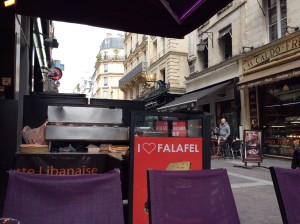
Slightly grubby, but friendly Les Halles felafel place. Great people walking byI liked the mint in the taboule, but I never need to eat another fava bean.
Then I drifted about, trying to find Dehellerin’s, where I’d been a couple of times before, but parts of Paris are like the shifting staircases and disappearing rooms at Hogwarts – they move about. So, instead of looking at tarte rings or little tiny boat molds, a beautiful gothic church emerged from the drizzle. As I opened the door, a young French couple came out and asked me what church it was. I told them I had absolutely no idea. I found out from about 40 signs inside. It was St. Eustache. It was gorgeous and peaceful. I sat there for about 20 minutes, then as I was leaving, I noticed three engraved panels of the pastor’s list. US churches often have a room with portraits of their pastors, often going all the way back to 1912 or even 1840. St. Eustache didn’t have portraits of their priests, but they had all the names and dates. Okay, RCA buddies in the Hudson Valley, this outdoes even your 350 years, eh?
I finally pried myself away, crossed the street, right into the evasive Dehellerin’s. There seems to be some sort of metaphor buried in there.
No more square cutters, but I did pick out exactly the tiny tarte molds that I’ll get before I leave.
And on the way home, I walked by the Communities of Jerusalem’s church, St. Gervaise, by the Louvre, by the two islands in the Seine, Ile St. Louis and Ile de la Cite. I walked across the Pont Neuf, the “New Bridge,” that is actually now the oldest bridge in Paris, started in 1578. I limped home in my bad shoes for another 4 miles because I walked up and down through St. Germain des Pres (Hemingway territory), Rue de Bac, south, then west toward Invalides. I looked left from the sidewalk and saw Rodin’s Burghers of Calais.
Right there. Just by the sidewalk. Another casting is in London by Parliament. It’s one of my favorite sculptures – the story comes from a 14th century battle of the 100 year war. The English King Edward III agreed to lift a year-long siege of the French city of Calais, if six of its leading citizens would surrender themselves to be executed and appear with nooses around their necks and the keys to the city to hand to the English. That’s the moment of the sculpture. The English were so impressed by the courage and self-sacrifice that they later freed them.
And onward, with the Dome des Invalides in sight (the old military hospital that is now a military museum, with Napoleon’s tomb just under the dome. I was limping like one of Napoleon’s soldiers on the retreat from Moscow at this point (darned shoes!), but I found the above-ground train at Grenelle, walked parallel to it forever to the corner with the MacDonalds and the Monoprix (the supermarket), turned left at Commerce, bought a bit of pate forestier (with mushrooms) and ½ a farmer’s chicken for dinner with the arugula I already had.
Tired and sated. It was a very, very nice day.
Oh, to be in England, now that spring is here
I’m in a very Browningish mood. I went to London for 24 hours last Thursday. I love London. I love England. I wish I could have stayed longer, but there you have it. I have an unusual eye condition that occasionally demands very quick treatment (a shot in the eye, so the less said the better for those of us who are squeamish. The bright side of it is that I can determine with authority whether any given situation is, or is not, better than a sharp stick in the eye.) The two French doctors who are experts in it were unavailable for a week, so one of the great London doctors at Moorfields Eye Hospital, near Euston Square and the University of London, moved heaven and earth to fit me into his schedule. Gratitude to those guys and their wonderful staff doesn’t begin to express my feelings.
So I abandoned my dear friend and houseguest Tryna and hopped on the fast train (the “Chunnel” [=Channel Tunnel] train) that runs from Paris Gare du Nord straight to London St. Pancras Station, adjacent to Kings Cross Station where the Hogwarts Express leaves from Platform 9 ¾. The train’s sleek, new, fast (only 2.5 hours from Paris into the heart of London), and well organized. It leaves and arrives on time. British customs officials scan passports in Paris, so that you just get off the train when you get to London and head straight to wherever you’re going.
I was surprised at how much I loved hearing English spoken, hearing all sorts of English accents. I’ve been in France, doing so much language and culture and cooking immersion that I didn’t realize what a let-my-hair-down relief it would be to hear English. I arrived two hours before my appointment, so I got pounds from a bank machine and headed straight to Fortnum & Mason’s. They shipped me 20-40 green tins of tea for years, so I have an emotional attachment to them, and the tins, in which I still keep quarters and old washers and screws and things.
F&M was the one place I knew where I could get great, fresh, loose tea before good internet distributors appeared on the scene. I moved between Earl Gray/Lapsang Souchang stages to Royal Blend, to Darjeelings and Orange Pekoes. My pots-of-tea a day habit continued with the focus and taste specificity of my current baguette obsession until I got Russ a Nespresso machine with those little pods of exquisite coffees with which you can make perfect cappuccinos and lattes and espressos. Within a week of getting that stupid machine, I’d gone over to the dark side. Daily breakfast switched from tea (with the huge pot in a cozy carried to my desk to sustain work-drive) to a remembrance of the favorite breakfasts of my life – hour and a half long conversations in my Spanish dorm over cafe con leche, pistolas (Spanish baguette equivalents) and very young Manchego sheep’s cheese. So you see why I have to make the best baguettes I can? Breakfast.
But after spending 20 hours on the phone trying to get international specialist medical treatment lined up, with more phones that In can tell you that DON’T have answering machines OR secretaries, long conversations with high speed French with the exquisitely polite wrong person, I was feeling a little regressed. Tea and the-most-English-thing-I-could-imagine-to-eat felt like comfort food. It wasn’t good Welsh rarebit – wildly over salted – but that was part of its charm and authenticity. It was so ENGLISH. And the tea was PERFECT. And it was served graciously. On silver. And everything was so CLEAN. The male waiters wore tails. Sherlock Holmes and Amelia Peabody and Dorothy Sayers and Elizabeth Barrett were just around the corner. I know it.
After a lovely interval, I went to the hospital and was well cared for. The doctor and his assistant were very kind. And oh, did that doctor know what he was doing. He was brilliant. I had a glimpse of the National Health System (Britain’s basic care available to all), and also the private system, since I was a private patient. They were both extraordinary – the same doctors and treatments were available to everyone at this internationally-known eye hospital. I waited for my angiogram in the NHS waiting room, which was more densely populated with patients with the international flavor of the new Britain – lots of languages, a huge range of people from what seemed to be widely divergent backgrounds. One elderly, slightly demented man navigated his rolling walker over my foot as he looked for his ride home. Being my usual officious self, I took him over to the right desk and asked the receptionist if he could explain the taxi situation to the gentleman. The guy sighed and said, “I already have. Four times.” We grinned at each other and he started in on explanation #5. It was organized, it was good care, it reminded me of a US city downtown emergency room – lots going on, and a busy staff that was doing a good job. My doctor told me that they give 50 shots a day for macular degeneration. That’s a huge number. They’re falling behind, because of the aging population, so they’re putting in another surgical injection room.
The private waiting rooms were different. They were rather plain, but with very well-dressed people with Oxbridge accents. English men actually carry black umbrellas and look like they’ve emerged from Central Casting. A nurse came in and murmured, “Sir Robert Something?” A 20 year old stood, grinned, slung his backpack on his shoulder and followed her out. Queen Elizabeth oversaw goings-on in my second waiting room. I was comforted by the thought. I also had a fascinating conversation with a witty, older couple. The wife had a nasty complication from a glaucoma surgery the week before. They visited America the first time during the Bicentennial and toured the White House. The tour guide gestured to vestiges of fire damage from British troops burning the building in 1812. The couple formally apologized to the group for British rudeness. I told them the story about Dolley Madison serving 24 for dinner, but having to race off to save George Washington’s portrait and a bunch of state documents before the Brits arrived. The officers ate the dinner, drank the wines, THEN torched the place. My new friends mentioned as how their forebears were rude, but not stupid. “It’s called foraging,” explained the account husband.
So after all the hospital things were done, I went back to my Travelodge (179 pounds a night – the hotel, not me). It had been the only thing available, and, as two Australian guests told me when I asked them if THEY had a phone or a hair dryer in their room, “No. No phones or hair dryers, but now they do give us the little bottle of soap that you can also use on your hair. It’s rather basic.” But anyway, that evening I wandered happily around Euston Square in search of the perfect English Dinner before I came back to France. I was NOT looking for tinned peas, so I found an Indian restaurant. It was pretty bad, but what a nice evening. My beloved who is hiking across the north of Spain on the Camino of Santiago de Compostela, called as I was ordering my Chicken Tikka Masala. I overheard conversations in French, some Indian language, and three English accents. I paid my bill and the waiters raced off around the corner. I was pinned like a butterfly against the wall by a huge 1930’s mahogany veneered table and two massive wooden chairs. Four beefy, middle-aged guys with Alfred Doolittle accents had just sat down at the table next to me. There was about four inches of clearance between tables. I couldn’t crawl under because of all those table legs.
So, I asked the guys if they’d have any interest in rescuing me. Two of them leaped to their feet, one saying, “Yes, of course, because we are English gennlemen.” And they freed me. I assured them that I had wanted to be rescued by English gentlemen for the better part of my life and thanked them very much. They introduced themselves, invited me to a second dinner. Who would have ever thought it would be such a great day?
What that REALLY means is…
In the southern US, when someone says, “Why don’t y’all drop by some time?” you need to know NOT to go to their house. It’s not a real invitation. It’s what you say in the South to be polite. Language and manners aren’t always literal. In America, to be polite, you leave some food on your plate “for Miss Manners.” In France, you finish every bite on the plate even if it’s a huge helping of nasty, detested, nearly raw pigeon or pan-fried foie gras. Even if you’re on a diet that your hostess knows about.
My French friend Christine came over for lunch last week. We know each other from Minnesota. She has spent huge amounts of time in the US over 28 years. She and I are really friends. We stood in the kitchen as I was plating the main course. Gesturing to the entire chicken available for just the two of us, I asked whether she liked white or dark meat. She smiled and said, “No French person will ever answer that question. It would be rude.” “But, Christine, that’s illogical, it’s just us. Pretend we’re in Bemidji. ” She smiled like the Sphinx or the Mona Lisa. I gave in and gave her a leg and a piece of breast. When she left, I just packed up half the chocolate-raspberry tarte I’d made (that she had clearly loved), and handed it to her, asking if she’d please take it home as a favor. I really wonder what kind of chicken she prefers. She ate it all. I probably won’t know until some end of time when all secrets will be revealed.
Again in the South (another foreign culture to me, so I notice things), when someone tells a scurrilous story about a woman she detests, the description frequently ends with the sweetest-voiced, “Bless her heaaaarrrt.” I’m from Ohio, but I’m pretty sure it’s the encoded equivalent of that word that real ladies don’t say, or at least don’t write in public.
I have heard French men and women do something similar four times – make fun of someone wittily, and at length, mimic them in a way I haven’t seen since 8th grade, then end the story with, “Mais, il c’est mon ami.” (“But he is my friend.”) Bless his heart. French humor is different. They mimic people. The Harry Potter audio book reader does voice characterizations that would appall Americans. Ron stutters. Hagrid mumbles in a low, SLOOOWWWW voice, “Duhhhhhhh, Haaawwwy…” This is the country that loved Jerry Lewis before he got nice and switched to doing telethons.
I think the only arena in which the French acknowledge political correctness is politics. Despite the crushing personal income tax (50% for very ordinary wage earners PLUS the 20% VAT sales tax), you don’t disparage poor people or old people who are being supported with the taxes. But lazy people on the dole are fair game. And it’s open season on German Chancellor Andrea Merkel’s shoes. And pants. And outfits. And hair. The woman is holding Europe together with brilliance, bailing twine and duct tape, but she’s not chic.
The French teach differently. I get a vivid sense of this since I’m here studying French cooking. Great American teachers encourage students with, “That was FABULOUS! Oh wait, there’s one tiny thing you might want to think about trying that might make it even BETTER…” French teachers don’t have to encourage students. A Parisian friend whose family came here from Africa laughs about Americans who all get trophies for showing up. “The French flunk out of classes – all American classes are filled with geniuses,” he boomed in one of those ringing African laughs.
A friend from my high school spent a year in a French lycée (high school). Francie wafted her way through a year of steady badgering by the French language teacher (essays in French returned with encouraging professorial commentary like, “Barbarisme !” “Execrable !”). At the end of the year, Francie was awarded the graduation prize for the highest grades in the class. Her thrilled mother crossed the room to thank the teacher. “Oh, oui, madam,” responded the teacher, “But, it was a very stupid class.”
I think an American supervisor must have given firm feedback to one of my first online Rosetta Stone teachers – Helene was a beautiful, stony-faced, French perfectionist. (We could see her. She couldn’t see us. That was probably a blessing.) American accents, misuse of articles, mangled grammar stabbed her like stilettos. A pained, straining-to-hear look flickered across her face as she listened. She snapped out neither “Babarisme !,” nor “Execrable !,” but they were engraved on her face. Instead, she employed her technique-for-Americans, acquired, I am certain, at great expense to Rosetta Stone management. She looked pained, but did NOT tell us we were wrong. She pretended to merely repeat what we had bumbled through in simple, elegant, restrained, classically correct French. Then she would nod, enunciating gravely, “Parfait.” “Perfect.”
My certainty grew that some Rosetta Stone supervisor had worked hard with her, making it clear that, although you can be critical with Europeans and Japanese, when dealing with Americans, one had to be encouraging, one had to give Positive Feedback, or they would grow discouraged, not have fun, and would stop paying for private lessons. These were, after all, volunteers, under no compulsion to study a language. “Tell Them They’re Doing Well, Whether They Are or NOT,” insists my imaginary supervisor to Helene. Life is painful. Suck it up. Just do this little thing.
One day, at the beginning of a 25 minute group session with Helene, she asked us to ask each other questions. Excellent exercise. I asked another American woman how she was, expecting her to respond with a polite French equivalent of, “Fine, thank you so much for asking. Lovely weather, isn’t it?” Instead, she answered truthfully, in worse than execrable French, giving us a pained recital about her husband being fired from his job, and something I couldn’t understand about her son in the hospital. Helene’s expression was a stunned replica of my husband’s when I ask his about his feeiings during overtime in a Final Four game. Helene’s lovely face contracted in a quick shimmer of horror. We shared a moment of silence. She then repeated the firing and hospital story in beautiful French. She stopped. She nodded. “Parfait,” she murmured.
Our pastry teacher in Lyon said that something was “perfect” every once in a while, meaning it. But David was a rarity. The most stunning positive reinforcement you can hope for among teaching chefs is “Pas mal” (“not bad,” coupled with pouched-out lips, jerked up eyebrows and a shrug). I hit the jackpot at Lenotre in a pate au choux/eclaire/religeuse class last Friday. I started piping tiny flames with a 4 millimeter star pastry tip around the little religieuse’s (nun’s) pastry head. I’m assuming this is a classic French halo effect for this traditional pastry. Nobody explains this stuff. but I had spent January obsessively practicing pastry bag piping technique to get ready for this French Adventure.
I whipped the first 4 little strips of angelic white buttercream flames into place. The chef lurked over my right shoulder. He watched two more flames flicker onto the nun’s head. “Ce n’est pas mal, eh?” (“Hey, that isn’t bad, is it?”) He waited three more stripes. He shrugged, lifted his eyebrows and said, with rising excitement, “Ce n’est pas map, eh?” I still didn’t look at him, but wordlessly finished the last 4 strips, neatly encircling the nun’s head with flames that fit exactly into the space. The chef honed in on a pitch-perfect imitation of my mom speaking English to people who only understand a language she doesn’t speak. “Ce n’est pas mal, eh ????” he shouted in my ear, bouncing on his toes in excitement. Judging from how bad my piping wasn’t, I may be being nominated for a spot in the Meillure Ouvrier de France pastry competition.
It truly wasn’t horrible.
The Best Baguette in Paris
This is it. It’s the best baguette in Paris, or at least it’s the best baguette in Paris’ sister. I’m here to tell you that I’m not arguing with the judges. It was superb – cream-colored insides with beautiful air pockets to trap runny cheese or sauce, and a crust that was both crackling and tore when you pulled it apart. I drank a cafe au lait at a little tea table in the bakery and stared at it.
This baguette was made by 24 year old Anthony Teixeira, baker of Aux Delices du Palais, a boulangerie/patisserie at 60 Boulevard de Brune in the 14th arrondissement, Porte de Vanves metro stop. As you come up from the metro at the Blvd de Brune exit, continue straight in the direction you’re facing. The bakery is about 10 blocks down, on a corner on the right. Paris has an annual baguette contest. They were worried that baguettes were tasting like those in American supermarkets or at Breadsmith.
Sorry to be rude, but the combination of machinery, dry yeast and fast rising methods produces Wonder Bread, no matter how pretty the loaf. Taste was disappearing, even in France, so about 20 years ago, Paris started a competition, Le Grand Prix de la Baguette Parisienne. It’s a big deal.
One day a year, hundreds of bakers from all over Paris submit baguettes that have to be made in the traditional way with the traditional ingredients: flour, starter or yeast, salt and water. No sugars, no additives, no fixatives, no freezing, not too much salt, the right size – just “la baguette de tradition.” That, by the way, is what you have to ASK for even in artisenal bakeries in Paris, or you’ll get absolutely beautiful….. (wait for it….) Wonder Bread. Enter the boulangerie (bread store), say, “Bonjour, madam. J’aimerai une baguette de tradition, s’il vous plait.” [Get your baguette, pay her the 1 euro and 20 centimes, or 1 euro and 40 centimes in a very fancy neighborhood.] Merci beaucoup. Bon journee, madam.” (See how polite you are?)
The contest, The Great Parisienne Baguette Prize is a juried, blind tasting of hundreds of submitted baguettes. The winner receives the honor of supplying bread to the President’s Elysee Palace each morning for a year.
The 2014 Grand Prix award was unique – never before had the same bakery won. M. Teixeira’s father was the winner in 1998. M. Teixeira Pere’s win is the reason the bakery is called “Aux Delices du Palais” (“in the manner of the delights of the Palace”). The 1998 honor is emblazoned on the signs in front, on statements inside, and on the edge of the cake and tarte wrappers. With the 2014 win, I suspect they’ll redo their signage.
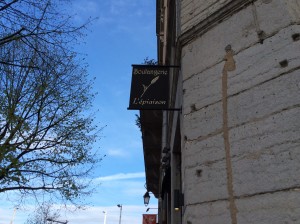
L’Epiaison, the great Lyon bakery – on the south side of the east-west street two blocks in front of the Vieux Lyon metro station, around the corner from the cathedral, and directly west of the Saone bridge over to Presque-Ile. THIS baker is my hero. Erica and Hiromi, my Paul Bocuse Institute cooking friends say it tastes like the best Japanese bread and they love it, too.
A word of explanation – I am as much of a baguette fanatic as exists in the United States. In the last couple of years, I’ve made well over 1000 baguettes in hand-made batches of 12. That’s a whole lot. I’ve experimented with various combinations of American flours, proportions, rising techniques, rising times, yeast/leaven combinations and baking temperatures. Our trip to France last January, with a nearly sign-language conversation in my five-month-Rosetta-Stone French with a brilliant Lyon boulanger spawned a fevered search to develop the perfect “levain liquid” (starter that isn’t normal, dry yeast).
I eat baguette every morning for breakfast, I ply the neighbors with it, Sandy, my buddy who delivers for UPS brings me 20 pound boxes of Bob’s Red Mill Organic White flour from Amazon and rumbles back down the forest driveway with baguettes tucked into the passenger seat. So I began the Paris leg of the Mad Baguette Pilgrimage last week. I headed to Aux Delices du Palais the first day I wasn’t in cooking classes.
I rode the metro to the south of the 14th arrondissement. I popped to the surface like a groundhog and spotted guys on the sidewalk selling 8 bananas and a pile of onions off of cardboard boxes at a very reasonable price. Maybe the food fell off a truck. A dad on a store stoop simultaneously watched an infant in a parked stroller, supervised his 4 year old on a scooter and smoked a joint. I, like the the groundhog, felt like diving back underground.
Now here’s the deal. If I wear my reading contacts, I can read my iPad, my computer, recipes and see the mushroom I’m turning, but subway stop diagrams and lower-shelf museum display explanations are muddy. If I wear my eagle-eye, long distance contacts, I can see the street signs in Paris. I was wearing my reading contacts. My iPad’s GPS was having a bad day. It showed the little dot that was me jumping lightly from block to block as I took five steps. I had no idea what direction I was headed. It wasn’t the neighborhood to be wearing your jewelry (I wasn’t), or flashing around an iPad. So, iPad in the purse clamped under my left arm, trying to look like a local (I didn’t), I strode boldly in a random direction, hoping to hell I was heading east on the Boulevard de Brune.
I had self-awareness of the Magoo-like quality of my activity over the next 12 minutes. Striking boldly into what was actually west on Boulevard de Brune, I marched under the over-pass, past a mattress with a covered, skeletal figure under a sheet. His shoes and hat were at the end of the mattress. I wondered if he had been raptured while the rest of us were attending to non-essentials like looking for baguettes. I skirted quickly past with firm tred, hoping a disembodied hand wouldn’t sneak out from under the sheet and snatch at my ankle the way my sister Sarah did that time in 3rd grade after I was fool enough to tell her I was afraid of someone grabbing me when I jumped into bed each night. There are some bad situations in life when you’re a victim, like car accidents and fires. But most of the time when you get into trouble, you’re just a volunteer. So I didn’t tell a soul what I was thinking.
The body under the sheet didn’t move. I did not tap on its shoulder to make sure it was alive. I walked two more blocks, sneaked another look at my iPad, no street signs being visible. I decided to head back toward the metro station and the guys selling bananas and onions, but to try the other side of the street. I turned left at a restaurant and discovered a seedy looking park with tulips braving blowing trash and the sign “Parque Auguste Renoir.” It was next to “Tabac Renoir” and “Brasserie Auguste Renoir.” Drawing quick deductions, I thought, “I’ll bet this has always been a dicey part of town. Most of the impressionists were poor, at least Van Gogh, but, well, except maybe Monet. Oh, yuck, look, there are absinthe drinkers at the Brasserie.” There were no well-heeled redheads with ruddy skin tones. Also, no baguettes.
So I headed back to the metro station, turned left and headed in the correct direction. 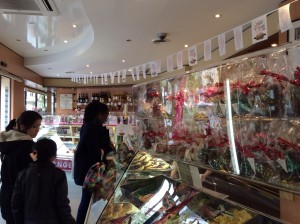 Ten quite respectable blocks later, I found Aux Delices du Palais. It was delightful. It was so normal. Easter candy sat on shelves, Little banner flags waved overhead, and, just like every bakery in Paris, baguettes stood in ranks against the wall behind the cash register.
Ten quite respectable blocks later, I found Aux Delices du Palais. It was delightful. It was so normal. Easter candy sat on shelves, Little banner flags waved overhead, and, just like every bakery in Paris, baguettes stood in ranks against the wall behind the cash register.
I waited in line with 3 ladies with headscarves holding children’s hands, 2 traditional looking French ladies and one man who carried shopping bags. When my turn came, the darling blond girl behind the counter (Madam Teixeira as it turned out), smiled and said, “Bonjour, madam.” I said Bonjour right back at her and told her I had come all the way from the United States to taste their famous and wonderful baguettes. “You have heard of us?” “Oui! You are famous for winning the Grand Prix de les baguettes de tradicion.”
So I got two baguettes and asked what else was very special that I should taste. She said that they had also won 4th prize in Paris for their macarons (the most famous French cookie – wildly chic and popular, so this is also a giant deal.) I asked for three of the little ones, which she had me pick out of the enormous case with 10 different flavors. Then she got my coffee, chilled my macarons in the quick freezer to make them perfect. The coffee was French coffee – this is not Italy. But after one bite, I understood what all the fuss is about macarons. That little, inch-wide, almond cookie with filling first crunched, then melted, then exploded with espresso flavor.
I tasted the baguette. It was stunning. I’m already envisioning the next round of experiments at home. I’m going to put more water in the dough, some subtle salt near the crust, a sprinkling of flour, and bake them browner. After a last conversation with Mme. Teixeira and many thanks, I left.
I stopped chez le fromager (at the cheese shop) in my neighborhood on my way home, clutching my baguettes. I fished euros out of my purse to pay for a little more Basque sheep’s cheese, gestured toward the baguette and asked my cheese guy, “Do you know what this is?” “Oh, madam, would you like me to put the baguettes into the sack with your cheese?” Ignoring the question: “THIS,” I said, “is the Grand Prix winner for the baguettes of 2014.”
“Oh-la-la-la-la,” he answered. “Who won? Where is the boulangerie?” I told him and asked if he’d like a taste. “Oh, oui, bien sur !” (of course!). I broke off a hunk and handed it to him. He grinned, turned his back on another customer who had just walked into the shop, and popped a bite into his mouth. “C’est formidable, eh? I will save the rest to share with my wife. You are very kind, madam.”
I smiled as I left, “It will go really well with cheese.””Oui,” he said. “Bien sur.”
Paris. I’m here.
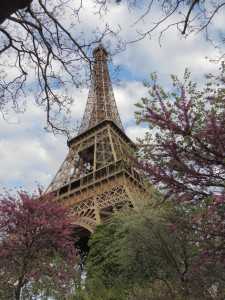 “Paris” means two things. At least. In French, it’s the word for the plural of “gamble/wager/bet.” And it’s the name of the most photographed city in the world, the city that’s a roll of the dice, a life wager, a challenge. So says essayist David Downie.
“Paris” means two things. At least. In French, it’s the word for the plural of “gamble/wager/bet.” And it’s the name of the most photographed city in the world, the city that’s a roll of the dice, a life wager, a challenge. So says essayist David Downie.

Felicia’s the little blonde figure in black to the left of the large black door, hidden in plants. This is my Where’s Waldo photographic technique.
Life itself feels like enough of a wild, glorious, fragile, blessed, beautiful, terrifying gamble that being in this gorgeous city fits. I’ve been here not quite a week. I feel at home. My lovely little apartment in the 15th arrondissement has tiny balconies on the street and french windows from the bedroom that overlook the courtyard. Every morning I open the curtains, the french doors and the metal shutters for the day.
This morning Felicia, “la guardienne” (the building caretaker) from Galicia in NW Spain was watering courtyard plants. I opened the windows, waved and whispered “Felicia! Buenos dias!” down from the third (European second) floor. She grinned and waved, “Hola, Marta!” We speak in Spanish always and it feel like home. Her Spanish is beautiful – just like my best Spanish friend Maite Ramos’ at the Univ. of Madrid – Gallegas are always the most friendly and comfortable. And after struggling to understand Pablo’s Uruguayan Spanish for my three weeks in Lyon, talking with Felicia is a delight. She is very proud of her 25 year old granddaughter who has been a doctor for two years, and of her father, who was such a presence in their village in Spain that they’re are going to put up a statue of him. I took her some different kinds of terrines that I made at the Cordon Bleu the other night. She’s a dear. We’re wearing sister outfits today – black pants and sweaters and hot pink scarves. Well, it is Paris.
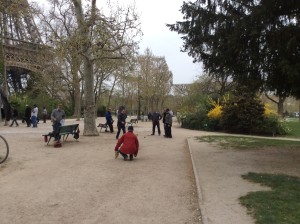 Old guys play boules (French version of Italian bacci) in the parks. There were four or five matches going the other day when I walked past la Tour Eiffel. 5-6 men playing in each, with spectators and concomitant commentary. It’s all oddly reminiscent of my past. Okay, we DID play bocci in our hallway when I was little (“Keep it on the RUG, kids!”), but this reminds me of going to London for the first time when I was in law school. I’d spent my life to that point reading Sherlock Holmes, Dorothy Sayers, Thomas Costain, English history and Dickens. Grandmother Reese had me reciting not only the English kings and queens from Ethelred the Unready to Elizabeth II, but also factoids about the War of the Roses by the time I was 10. London felt familiar when I saw it for the first time, even though I’d only seen the Trafalgar lions in my imagination. I kept a weather eye out for cockney pickpockets, Sairy Gamp rounding the corner, or Holmes striding through fog, pretending to be blind.
Old guys play boules (French version of Italian bacci) in the parks. There were four or five matches going the other day when I walked past la Tour Eiffel. 5-6 men playing in each, with spectators and concomitant commentary. It’s all oddly reminiscent of my past. Okay, we DID play bocci in our hallway when I was little (“Keep it on the RUG, kids!”), but this reminds me of going to London for the first time when I was in law school. I’d spent my life to that point reading Sherlock Holmes, Dorothy Sayers, Thomas Costain, English history and Dickens. Grandmother Reese had me reciting not only the English kings and queens from Ethelred the Unready to Elizabeth II, but also factoids about the War of the Roses by the time I was 10. London felt familiar when I saw it for the first time, even though I’d only seen the Trafalgar lions in my imagination. I kept a weather eye out for cockney pickpockets, Sairy Gamp rounding the corner, or Holmes striding through fog, pretending to be blind.
In Paris now, I’m unconsciously looking for Desiree Clary, Audrey Hepburn, Cary Grant and Gene Kelly, Porthos and D’Artagnon, Cornelia Otis Skinner and Emily Kimbrough. I haven’t seen them yet, but their friends make appearances. These people are so French. I bought two 100 gram slices of cheese on Saturday after prolonged discussion about which would be perfect. This was 2 hours after my train hit the station. (It’s Lent. Confession time. First purchases: a little Chanel makeup, a baguette and cheese. Mais, bien sur. [But of course.]) Result of consultation: a wildly ripe goat cheese covered with cinders and a very young Spanish sheep cheese from the Pyranees. Both were exquisite. I returned yesterday, to be greeted with, “Ahhhh, bonjour, madam ! And did you like the sheep’s cheese ?”
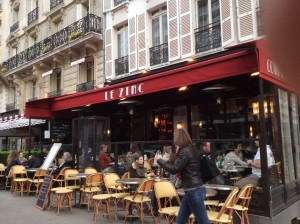
Random cafe. Our wedding dinner was at Bistro Zinc in Chicago, so I whipped out the iPad to send this photo to my beloved.
I assured him that he was my hero and that I was in need of MORE of the sheep’s cheese because I couldn’t possibly exist longer without further enjoying its flavor.
My first class at L’Ecole Alain Ducasse was interesting. I arrived early on Tuesday and watched everyone walk into the courtyard. Skinny pants, fancy handbags and stiletto boots or 4″ suede heels with jeans. EVERYONE, men and women, wore a snappily-knotted scarf. “Cooking?” I thought. “These people are cooking dressed like this?” Well, as it turned out, most of these visions weren’t going into the cooking school – there were other offices in the building. In the class, a 35 year old French woman played at Parisienne restraint for the first couple of hours – pouty eye rolls, one shoulder shrugs, moues (nothing I learned in MY high school). She avoided eye contact with the older French guy, the attractive young Brazilian woman who sounded just like Penelope Cruz, and me, sparkling only for the chef. This not being my first day at the rodeo, I knew not to negotiate with terrorists (if you do, they win) and translated for the Brasilian woman who spoke no French. The three of us had a great time making glorious fish soup with “rouget” – a beautiful, small red mediterranean fish, seared then roasted leg of lamb with jus and about 6 kinds of vegetables.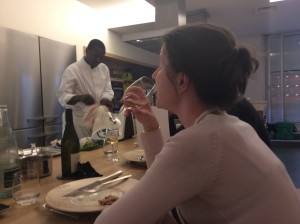
After 3 hours and the first glass of wine, French girl asked what nationality I was (I’d given my name as “Marte.”) I asked what they thought and the guessing game began. She glanced lingeringly at my feet and said, “Dutch?” (I don’t think she knows about accents, but the Dutch are the Europeans who laugh in public and probably wear hideous shoes.)
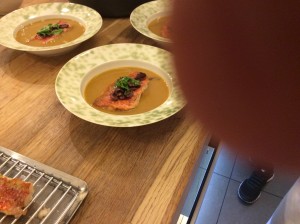
Here’s the fish (rouget) soup, with a base of chicken stock, piment de Espelette, fish stock, topped with olives, basil, vinegar and olive oil.
Other guesses were English and “you’re not Spanish, are you?” Okay so I’m not letting down the team. It may be the high point of my international life. Moral: wear black with a scarf. Go to friendly Lyon first for three weeks to learn to mince a shallot into 5-molecule-thick cubes. Christine (faux name) ended up giving me directions to three cooking supply stores by Les Halles and writing them into my iPad herself. Everyone happy.
So, one more story. I was meeting my friend Erica from Lyon (and Hong Kong) at Les Halles, the spot where the huge Parisian food market used to be. The old market is now a shopping center, at that moment filled with 537 French teenage girls lined up for an open-call modeling competition for Elle magazine. Riot police in full gear stood by to quell disturbances.
I rode to the top of the metro station escalator to wait for Erica. A middle-aged man sat on a bench right at the tip of the elevator, wordlessly extending his right hand. He wore a lampshade on his head. It was white with gold trim and tassels. He also wore bright orange tennis shoes. Then another man strode across the plaza toward him, talking in a delighted voice. Lampshade man jumped up, arm extended. The two men shook hands like bankers, They bowed slightly to each other, exclaiming graciously “Je suis ravi de vous voir” (“I am ravished with delight to see you”) and that it had been too long. The first man, in the tennis shoes, raised his lampshade and tipped it like a bowler, then extended his hand hospitably toward the bench to his left. They chatted amiably, the original man’s hand extended to people exiting the subway escalator.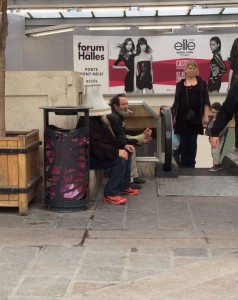
Moments later, a fancily dressed, middle-aged woman in black came up the escalator, smoking. I’m not sure whether or not she was a hooker, but the possibility exists. (This, I suspect, is another area of weakness in my Preparation For Life by the Baldwin School in Bryn Mawr, Pennsylvania. Cornelia Otis Skinner mentioned the same gap in her Baldwin education in the early 1920s.*) The woman in black caught my eye, raised an eyebrow, smiled slightly, pulled two cigarettes out of the pack in her purse, then handed one each to the two seated men. “Ahhhh, madam. Vous est ravissante!”
Toto, we’re not in Bryn Mawr anymore.
*Our Hearts Were Young and Gay
End of an Era – Dinner at 3 Star Michelin Restaurant Paul Bocuse

Erica and I remembered that we are ladies and went out to dinner with Paul Bocuse. This restaurant has had 3 Michelin stars since 1965.
I’m on the train for Paris as we speak – the TGV, the fast train that like Lenin’s sealed train from Vienna to St. Petersburg, doesn’t stop and that goes straight from Lyon to Paris in two hours. This train zooms comfortably through a gorgeous day outside – about 65 degrees and sunny, and a Very Kind Man hauled my impossibly heavy bag onto the rack for me.
I tried to pack lightly and given the length of the trip, I really did. I brought the ends of bottles of shampoo, makeup, face soap, deodorant, contact solution, hairspray from St. Louis, then threw all of them and my smouldering brand-new hair dryer away this morning and will get new ones tonight in Paris after I get to the apartment. However, despite the fact that I gave away a bunch of the cooking equipment, two books, the striped chef’s pants, the clogs that weighed a good 6 pounds and the heavy backpack case they all came in, I STILL managed to collect more stuff. I stuffed in my aprons, four towels to hang on your belt, the two chefs ‘ jackets and of course a bunch of Lyonnaise silk mousseline scarves (they’re light, they’re small!) and the 5 pound Complete Paul Bocuse cookbook that 88 year old Paul Bocuse signed for me, “A Martha, Le bonheur est dans la cuisine [Happiness is in the kitchen, or in the cooking.] Paul Bocuse.” We didn’t get to meet him when we went to his restaurant and toured the beautiful kitchen and met the MOF who runs the kitchen. Chef Bocuse had a serious back operation this spring and is in a rehab center. And he still signed books for us. Very precious books.
We went to his restaurant on Thursday night – the night before our last day of cooking. It’s the only 3-star Michelin restaurant in Lyon and it feels very much like the way it was when Julia and Paul Child ate there. There is a wall of perhaps 8-10 murals in the courtyard as you enter the restaurant with great chefs and descriptions of them. The light was shining on my American heroes, James Beard and Julia Child, so the pictures didn’t come out. But Erica and I are here with Paul Bocuse and friends.
The Michelin star system is as brutal as the competition for the MOF (meillure ouvrier de France, see the entry “Polite and Practically Perfect, below).
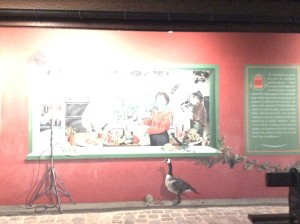
You can see the outlines of my heroes, Julia Child and James Beard in the Bocuse restaurant courtyard.
It’s a wildly rare honor to have one star, let alone three, and losing a star is horrific. A famous chef committed suicide several years ago after he lost a star and descended from three to two. The pressure is tremendous. The restaurants try to keep their presentation fresh, absolutely chic, creative, modern, with every detail compulsively perfect.
Stars add to bookings, stars add enormously to the amount restaurants can charge, stars add to the reputation of the chef. Three stars is the apex of the pyramid. Paul Bocuse has been given the [I think unprededented] honor of having three lifetime stars. The other example of amazing-in-the-star-department is next-generation chef Alain Ducasse, in whose school I’ll be studying for five days in Paris. Ducasse, also author of many cook books, is the only chef to have NINE Michelin stars concurrently – three each for three restaurants for which he’s chef de cuisine (one is the beautiful restaurant in the Eiffel Tower. He’s another culinary and PR genius.
But back to Paul Bocuse – it’s an old-fashioned restaurant, with the classic food, presentation, and ambiance. And it’s absolutely full. We went on Thursday night, and virtually every table was booked. Here’s my dessert:
We had dinner with the whole class and Chef Patrick – very fun. I had a beautiful lobster starter, then loup (sea bass) with a bernaise sauce flavored with a little tomato in a pastry crust. That was staggeringly good. Then cheeses, then dessert, then coffee. I kept imaging the Childs, and James Beard, and my grandparents eating the same food in the same room, laughing with friends over fabulous food – having a wonderful evening. It happened. It all happened.
Last days at L’Institut Paul Bocuse

Chef David assembling a franboise religeuse. We thought the pink little topknots (with real gold leaf on the forehead, a la halo) looked like Barbie Doll pink. Really, the German came up with that one.
What a beautiful last week. It was pastry week, with Chef David, head pastry chef for 12 years in a 3 star Michelin restaurant near Bresse, north of Lyon. (Remember? That’s where the best chickens in the world are raised.) We’d all been foundering with the staggering quantities of foie gras and truffles, but I’m here to tell you that a surfeit of sugar tasting is (a) a fun change, (b) strange.
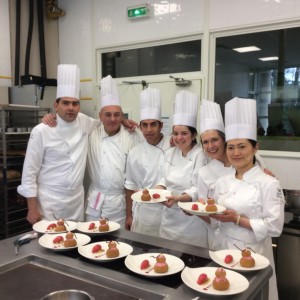
I was chef (head of the team) for the day we made the framboise religeuse. Here we are, David is the tall one. I’m taller than Hiromi.
You start craving salty things and protein and telling everybody NOT to make a plate for you of the framboise religeuses (“raspberry nuns”) or the tartes aux cinq chocolates. I was the chef in charge of a team of five making the lovely, creamy, raspberryish framboise religeuses, and the thought of eating a whole one after testing bits of the six component parts of that dessert all day was oppressive. Erica brought plates of salty crackers and Guiness beer cheese to cut the sugar the last two days. We were actually hungry for lunch for the first time since we got to L’Institut Paul Bocuse. Protein is a great thing. But sugar is incredibly fun to work with.
The oddest thing is that you shift ingredient palates. We’d been grabbing olive oil and salt and pepper, meat, fish and sauté pans with impunity for two weeks. (Parethetically, “pepper” is pronounced “paper” with a French accent.
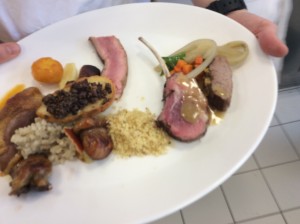
Or here – THIS is cuisine. That would be veal, lamb, beef, risotto with seafood and other various and assorted trifles.
The first week Chef Patrick asked (in English) for “paper” and I dashed to get him the roll of rough gray paper towels. He started laughing, put his hand on my shoulder and said, “I know my English is bad, but I want PAPER, white PAPER.” Oh,sorry, I laughed and went and got him a couple of sheets of the white parchment paper under the counter. He then led me by the arm to the salt and pepper by the windows. “Paper,” he said, “paper.”)
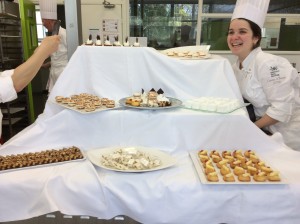
THIS would be pastry, and our darling Elodie, who some started calling our “baby chef.” How misleading! She can outlook almost everyone with one hand tied behind her back.
Anyway, we’d been developing great comfort with all the cuisine ingredients and the ways to cut and cook and slice and carve them. This week we’ve been in vanilla, pectin (did you know there are two kinds?), flour and fruit land. However, I can now report authoritatively that the constant in all French cooking, both cuisine and patisserie, is butter and cream. BUTTER and CREAM. In staggering quantities.
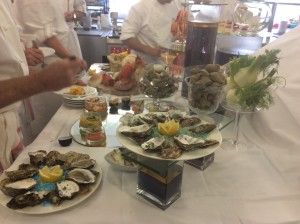
The next door neighbor class invited us to taste shrimp and oysters on Wednesday after I gave them our tray of little glasses of fancy desserts on Tuesday.
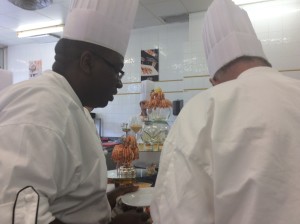
The other class. On the left is my friend from the Ivory Coast. He SMOKED the final test this week. Hotcha!
The other difference with doing pastry work rather than cuisine is that people stand outside our kitchen, elbows propped on window sills, eyeing you like starving children. I started making loads of friends when I noticed the voyeurs. I’d swoop over, scoop up a couple of macarons or little choux pastries, or tiny glasses of mousse-y things and would pass them out the door. Instant delight! I gave my box of a dozen little macarons to the receptionists at the hotel. (Macarons seem to be the most popular sweet thing in France. They’re almond cookies held together with different fillings. We made some with raspberry jam and chocolate hazelnut ganache on Wednesday.) I came downstairs 20 minutes later to put in a load of laundry and the receptionist was in the breakfast room, covering her mouth with her hand and chewing. She said they were the three best macarons she had ever tasted. Your stock is really high when you can impress is French woman with your cooking. Many try, few succeed. I’m here to tell you, that’s fun.
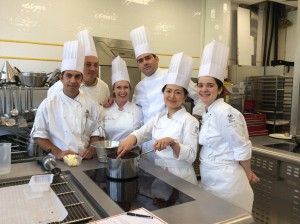
Here was our 6 component death by chocolate tarte with vanilla ice cream. It was really, really good.
So it has been a great week. David is a terrific teacher. We did classic creams and pastries and doughs and chocolate things enough times to really get a feel for the themes and variations. The class was beautifully structured, he had us all divide into teams and mis-en-place the ingredients (put them into little bowls and get everything organized and weighed), then we’d watch the team explain the process and make whatever it was we’d prepared, with David assisting. I can’t imagine him doing a better job of teaching. And oh, did I learn a lot. There are huge subtleties with pastry – exact quantities and really precise temperaturesand ways of stirring are paramount. The stuff is fragile.
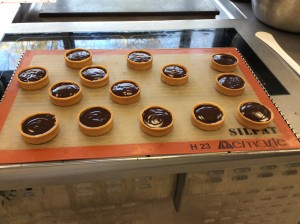
This is three components of a 6 component chocolate dessert (there’s a cookie on the tart, under the dark chocolate mousse. But look t those crusts!
My pastry dough is now really good – and I’ve learned the feel of working with it the right way – with the 90 degree angles of very thin pastry. That was worth the price of admission.
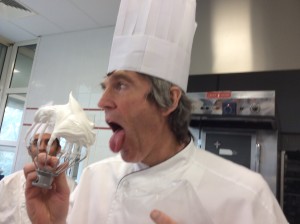
Raymond from Luxembourg didn’t seem to have the problem with sugar overload. He’s quite the chocolate guy and whipped cream worked for him, too. He kept running 15 kilometers after school, so things do even out.
I’m sorry we didn’t do boulangerie – bread and croissant making, which is what I know most about. It’s a completely different discipline in France than cuisine and patisserie, but I got to revisit my favorite baker in Lyon, who toured me through his kitchen last January and gave me his proportions, timings and the secrets of “levain liquid” (starter, but not to the sour degree of sourdough starter – quite a different taste).
It had been an incredible three weeks. I’m so grateful that I was able to do this first. It has given me a basis for all the rest of the cooking I’ll be doing. One of the greatest gifts of the time has been the new friends – our class was wonderful. We all spent this last week having that end of camp feeling. We’re done, and we did well. And it was great.
First pastry classes with 3 Star Michelin pastry chef
Quick like a bunny, here’s a report from today. Don’t let it detract from yesterday’s post, which is more of a deal in my mind. This is just pastry. Today, we came home from class, I dumped my stuff in my room and went out with Erica to (a) buy some glorious Lyonnaise silk scarves, and (b) to take a thank you gift of some wild rice from the Mille Lacs Tribal grocery store to my favorite boulanger (baker of breads) in Lyon> He showed me what he did lat January, gave me his recipe and proportions and helped me take a quantum leap in baguettes. So, I ended up having about long conversations in French with people in the silk shop (one fascinating couple – he’s a musician and their 2 children each married Americans about food and Lyon. The second conversation was with two older women in the silk shop about the disappearance of the traditional artistry of the silk scarf painters (the ones who make the couturier scarves for Chanel, Dior, Hermes). This store is the local outlet, but their main customers are the Parisian couturiers. (See their website -www.tousoie.com.) But we talked about the disappearance of the amazing artists who do this work, the lack of young people who want to take their places. It was a poignant conversation.
But here’s the quick update. We started pastry classes yesterday and only have 3 more days at the Paul Bocuse Institute. We’re all in grief at the thought of this tremendous experience ending. But just to give you a taste of the greatness, here is what we did the first two days of pastry class. Our teacher is a young guy, fabulous teacher. I’m learning something new every 5 minutes. For 14 years, he was the head pastry chef in a 3 star Michelin restaurant near Bresse (where the world’s best chickens come from – see photo 2 posts ago). He had 3 bakers and 5 pastry chefs working for him and now he’s teaching here. For those of you who don’t know, a 3 star Michelin restaurant is the most coveted and rare restaurant designation in the world. I’ve never been to one. Our class will go to Paul Bocuse’s own restaurant (the only 3 star restaurant in Lyon) on Thursday. So, in our new pastry class, we are learning great things.
Monday: 3 classic desserts with loads of dessert techniques –
- Lemon tarte (Tarte aux citron)
- Tarte aux fruits exotiques (a tarte with almond flour and coconut in the crust with mango, kiwi and pineapple on top)
- A pear charlotte (lady fingers with bavarian creme and pears, with dark chocolate decorations on top)
here they are:
Tuesday: verrines, mini-desserts layered in tiny little glasses, as I recall:
- chocolate mousse with coffee bavarian creme, topped with a coffee whipped creme, chocolate coffee nougat and gold-covered chocolate mini-balls
- pistachio pannacotta with strawberry glaze, fresh strawberries and pistachio almond crumble (pablo and I did that one – it’s the diagonal line across the middle of the desserts), with carmel-covered pistachio decoration.
- raspberry mousse with an almond blanc mange, raspberry conserve, fresh raspberry with a crumble top, and a carmel sugar decoration a hazelnut
- mint cream with lemon jelly (sort of like a dessert aspic), topped with crumble and crystallized lemon jullienne
- apricot something or other (big chunks) with 2 other layers I don’t remember (I haven’t tasted this one yet – I saved it for breakfast).

Pablo’s and my pistachio/strawberry crumble concoction is the long diagonal lin i th emissive. Note the pistachio spiky thing in the middle of each one – it’s a 4-5 inch thread of carmel spun around and out of a pistachio.

Our demo desserts from the side (these are the ones we gave our neighbor class – there were 40 of each of the 5 sorts of desserts. It was fun!
Anyway, they were all fabulous. We gave little presents of the nuts covered with carmel sugar long tapering spikes to our next door neighbor class (the 6 week professional class), when they trooped in to see what we’d at 4 o’clock. Pablo and I finished first, so I got to do the full presentation of the desserts .
We also traded my box of take-home desserts to the bakery chef who promised to give us his recipe for baguettes and croissants tomorrow. Tomorrow is macarons. this is the dessert that EVERYONE tries to do right. I’ve tasted theirs. These guys do it right. I’ll have things to share when I get back. Start working on your Italian meringue, guys. More later.
Bonus pcture: Chef David’s quick sugar decorations (a treble clef, a series of concentric circles, and a geometrical interweaving set of cool-looking-things. They’d go on top of a dessert and stand up. They also taste exquisite.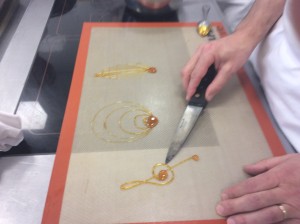
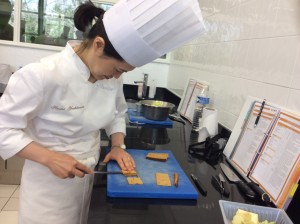
This is Hiromi. One of the great joys of the world is to watch her cut vegetables, particularly little, intricate cuts.. It’s tai chi with a chef’s knife.
Polite & Practically Perfect
I was standing with my friends Hiromi and Elodie at the coffee bar at L’Institut Paul Bocuse on Wednesday, waiting for my “café alllonge” (espresso with some extra water because I considered it ill-advised to belt back another double espresso). Hiromi is a professor of cognitive phycology from Tokyo living here for a year. Elodie has become one of my favorite people. She’s 21 and a native of Lyon. Her parents are from the Auvergne, which is the gloriously earthy region just to the west. Elodie asked, “What do you think of the French people – we don’t know what we are like because we are normal for us.” The question sparked a whole train of thought. What are French people like?
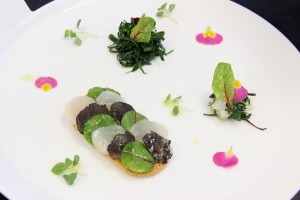
Raw scallop & truffle rounds brushed with vinaigrette on a parmesian sablee, with a little spinach salad in the same lemon vinaigrette. With herbs and primrose petals. This one was all Chef Patrick’s.
I think French people are wonderful. They’re kind, sometimes slightly cynical, funny, relational, very polite & often perfectionistic. This is one of the most visual cultures I’ve encountered. I suspect this orientation toward the visual and exactness is exacerbated for the elite cooks with whom I’m coming into contact.
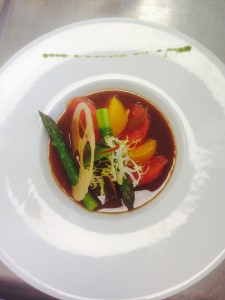
One of the zillion foie gras presentations from last Tuesday. Gosh, does a little of that stuff go a long way with me!
Many, Elodie particularly, are charming and outgoing – demonstrative, fascinated by many things – cooking, design (she’s finishing one program in design and applying to the best industrial design school in France. She doesn’t care WHAT she’s going to design – chairs, cupboards, bicycles, sleeping cubicles, magical animal-people that look like medieval illuminated manuscripts. You ought to see her dossier or projects for school. She has huge eyes and just had 10” of hair cut off, because it was getting “fatiguees” (split ends). I keep finding myself having the feeling I do with Corgi and German Shepherd puppies. I want to take her home – I know that Elizabeth and Sarah would get along with her beautifully. 😀 [There’s a photo of Elodie at the top of my last post]
You say “bonjour” to everyone you pass at school, the clerks in the store, the women at the desk of our “apart-hotel” and the bus driver. You say “bonjour” BEFORE you tell them what you want to buy, or you’re being unutterably rude. You say “bon journee, madam” when you leave (a “have a great day” equivalent). Clerks take an enormous amount of time with everyone – it drives you crazy when you are standing in line. It’s restful and rather self-indulgent when your turn arrives.
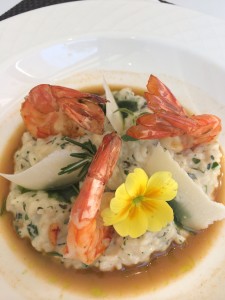
A rather snappy risotto, e4h? Most of them had bright pink flowers. I was the major risotto stirrer. Quite the claim to fame.
I had a 10 minute conversation (no one else in the store, actually) with two women clerks at the pharmacy yesterday. They wanted to know what I was studying at the Institute, where fascinated by the 10-people-from-9 countries-in-my-class thing. They asked about the Paul Bocuse Institute (“Is it a really good school? We don’t know what other people think about it since we’ve always been here.) They were thrilled to know that it was an extraordinarily good school, possibly not as well known outside France as Le Cordon Bleu, but much, much better in the opinion of les connoisseurs. There are three “MOFs” here – “Meillure ouvriers de France,” which translates into “Best French workers” and it’s a huge deal – This wildly rare distinction given to perhaps 20 chefs every three years – the BEST pastry or cheese experts, or cooking chefs in France. There’s a movie about it.
Being a MOF is a huge deal. They wear tri-color collars on their white uniforms for the rest of their lives. One of the pastry chefs won the 2009 competition as the best pastry chef in the world. HIS collar has the flags of all the countries he beat. The competition is being held again this year, in May with the second round in November. My teacher, Patrick Chabassier, is going to compete. 600 chefs enter the competition and by the end of the first day (a long, intense written exam, and random skills tests), 300 chefs are eliminated. In November, semi-finalists have 3 weeks to prepare with the announced lists of ingredients and techniques that they’ll be required to incorporate into a meal). Sounds as if it’s pretty much Nightmare City for the contestants between now and then.

Everybody’s always carving things – diamonds out of potatoes, birds out of zucchini. Pablo, my cooking partner and chef to the princess is great at it and leaves them as presents on my cutting board. THIS one is from the amazing next-door chef, who’s also going to do the MOF competition in May.
One of the MOFs judged a test for the students of the six-week course that’s going on simultaneously with ours. I had a long talk about it last night in the laundry room with the sweetest guy in the world, here from the Ivory Coast. At home everyone loves the food he makes, but yesterday’s test with the MOF was “un catastrophe !” The plate wasn’t hot so the chef rejected it and told him that wasn’t acceptable. There was talk of “…dans la poubelle.” […into the trash.] This kind of thing make students So this sweet man is wonder whether they should try to be chefs. Maybe the dream isn’t reasonable. I told him one of Russ’ favorite bits of advice for me under similar circumstances (the “shake it off, Martha Grace” speech). When I went down to change loads 40 minutes later, he got the call that his wife’s train had broken down and wouldn’t be in until midnight. That was the kind of day it was. Aargh….
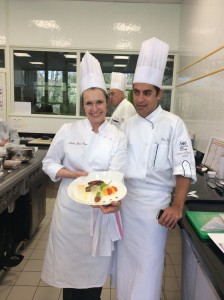
Pablo and me with some foie gras. I may be the only one who doesn’t like pan-fried, highest quality foie gras. We cooked 10 pounds of it in about 437 different ways. (Okay, maybe 12 or 15 ways). There were also 13 lobsters
The clash of cultures with the French chef’ sense of exactness, or perfectionism is painful for the sensitive and the compulsive. The Swiss guy in the six-week course also had a “catastrophe” in yesterday’s test. A week ago Wednesday, I had a Terrible, Horrible, Awful, No-Good-Day, or whatever that Alexander book title was when Elizabeth was little. It involved a cancelled bus, being 5 minutes late, shoes that didn’t fit and launched orthotics out the back like projectiles, a lost hat and some other stuff. Chef stopped class. He slowly left the room to GET me another hat, quietly, with a look, interrupting the entire demonstration on fish. I re-experienced EXACTLY the feeling of mounting tension, panic and guilt when Mom lost the car keys for 15 minutes, wouldn’t let 6-year-old mini-me walk back to school after lunch. I was late and Miss Green, the pencil-thin, 4’9”, pin-curled, box-pleat-skirted, Woodside principal gave me a lecture on not being careless and late. I think that French cooking schools are more restful for people who aren’t wired so tightly – for the guys whose first reaction to a thwap upside the head is, “What? Wha’d I DO?”
But it’s incredibly fun most of the time. It’s fascinating. We are learning cooking techniques that are very subtle, taste profiles and ways of developing so many layers of flavor. One high point was when the chef asked to take some of my blanquette de veau home to his wife because it was exactly right (with the kissing of the finger tips). And if my hyper-sensitive, perfectionistic little feathers get ruffled occasionally. I don’t really care. It’s just too fascinating to take personally.
Food, perfect food – in taste, in visual appeal, is an art form. That’s the message. It’s not to be taken lightly, but with seriousness and with humor. Our future lives will be full of critics. These chefs are here to teach us how to avoid cooking things wrong – to avoid being busted by outsiders. I think that’s close.

a goat cheese. It started round, but that lower left corner was my dinner one night. It was exquisite.
What are the French like? Why am I here? Why did I pick Lyon and this school? What do I think about the French people? They keep asking – the doctor asked me, my French friends wonder, the receptionist at the apart-hotel, the lady at the pharmacy.
So here’s what I think. I think the French people are kind, warm, curiously vulnerable, generous, have the slightly pessimistic outlook – their economy is problematic right now and life is difficult. Many people are quick to laugh and truly relational. Greetings of “bon weekend” and “ca va le weekend?” (“have a great weekend” and “how was your weekend?”) seem heartfelt. They ask and they care. When they say you are kind, you feel kind. Their visual perceptions are quick and incisive (people, style, the knotting of a scarf, the perfect triangle of a quenelle, the 7 sided turned vegetable, the arrangement of glasses and spices, the collar of your raincoat). I’ve heard the saying “you first taste with your eyes,” about 8 times.
So look at the pictures of the food carefully. They’re what the French people are like.
Paul Bocuse 3 week intensive course: Stepping onto a Moving Train.
Woosh, what a first week. I love this place and these people. I’m sitting in my little apartment, eating leftovers from last night’s cheese tasting with a glass of Chateau Neuf de Pape bought at the little grocery store named “Casino” on the corner, thinking specifically of so many of you who may read this. I hope the little piece of Roquefort that was missing from my grubby little wrapped up package of cheese isn’t in the bottom of my new purse mashed between the lining and some metro tickets. Shrugging that thought aside, it has been an amazing week and I’m so glad I’m here.
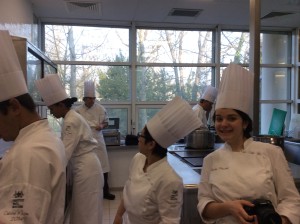
Our class – the smiling little sweetheart looking straight into the camera is Elodie, age 21, our self-appointed guide to Lyon, her city. She’s making it our city, too.
10 of us from 9 countries have hit our kitchen at L”Institut Paul Bocuse at 8:30 a.m. and stir, ciseler, blancher, mincer, gratiner and nettoyer our way toward 5 o’clock. Two nights we’ve had special lectures/tastings (tea and cheese this week). I actually counted the steps of the chateau today and it added up to over 1000 in an average day, 1500 on Monday. Okay, that counts up AND down, but I think that’s fair arithmetic as you run up and down chateau steps, trying to straighten your apron, keep the safety clogs on, and not drop the chef’s hat as it drifts backwards as you simultaneously grab for the railing and smile “bonjour” to the guy in a suit running the staircase in the opposite direction.
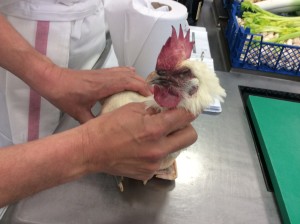
Poulet de Bresse. It really was staggeringly good – truffles under the skin, cooked in a salt/flour/egg white/water coating, then served with a cream, foie gras truffle sauce
Chef Patrick Chabassier’s cooking is mesmerizing. Everything he does with food is quiet. He doesn’t announce demonstrations. He starts doing something. We dash toward him and ask questions to figure out the technique – what is he SEEING that cued him change the heat? What’s he smelling to know it’s time to dump the old butter out of the frogs’ legs and add the butter-herbs-garlic-anise liquor-cumin mixture he had me make? I can’t imagine forgetting the image of this man as he gently juliennes carrots, or reverently rests his hand on the Poulet de Bresse as he explains that this is the best chicken in the world, then smooths its head feathers, pulls at its joints and takes out the neck. He’s quiet. He’s funny. He’s very French, with great kindness and a lovely sense of humor.
He conveys wordlessly a respect for la cuisine Francaise and for us as we’re trying our level best to soak up every insight tired knees will allow overstretched brains to absorb. Today he made the lobsters wave to us. Since it was Friday, we got several renditions of “It’s FRI-day…,” with an ’80’s dance, alternate fingers pointing up. French cooking is hard and French cooking is fun.
Now, for L’Equipe, The Team There are 10 of us from 9 countries (The repeat is Holland, then Luxemburs, Hong Kong, Germany, France, Bulgaria, Uruguay, Japan, and me.) This is one of the nicest and most high powered group of people I’ve met in ages. Our course for obsessive amateurs is 3 packed weeks long and called “Cuisine et Passion.” We do have one professional chef in the group.
Pablo is from Uruguay, where he cooks for a Hapsburg princess. We asked him what he cooks for her and he said in Spanish, “foie gras and things like that.” We nodded understandingly and murmured, “ahhh…. Princess food.” With very different personalities and backgrounds, the group is funny, thoughtful, and kind, with a real feel for food. I haven’t had long conversations with everyone, but may of the stories I’ve heard so far feel familiar – people who have worked hard at professions they love, cooked intensively most of their lives and realize that they want to do once-in-a-lifetime things now, because it matters. Time is precious.
There’s a venture capitalist; an oncological surgeon; a Cisco manager who heads a team that’s working with China; a beautiful Japanese woman whose husband has a sabbatical and who decided to take a year off to be with him; a darling 21 year old from Lyon who’s in cooking school, but spending her spring break here cooking; a German marketing expert who looks like a supermodel, hunts and field dresses deer. (She sent me an e-mail last night with a reminder that although life without creme is possible, it’s utterly meaningless. Anna’s next to the chef in the lobster cutting picture.) The Dutch chief of oncology is to the right. You ought to SEE the way that guy turns mushrooms – small motor coronation like Heifitz’s. Upon mature reflection, that’s probably a VERY good thing.
We’ve worked hard core all week on the French classics – 10 kinds of fish Tuesday, stocks and cutting techniques and vegetables on Monday, Meats (lamb, beef, veal, chicken and rabbit) on Wednesday, probably 15 sauces during the course of the week (you ought to SEE my sabayons and beurre blanc at this point) and all the crustaceans on Friday. Details later, but just enjoy this photo of captains of industry, marketer, doctor, writer, researcher swabbing the decks in the kitchen. Our new hobby, as Paul from Holland said, is washing and IRONING our uniforms. This is a group of people that I suspect don’t typically do a lot of ironing.
Oh, I just found the lost nugget of Roquefort. NOT smashed in the purse. Hurray. Life’s good in Lyon.
I’m here. I love it! And some travel epiphanies.
It’s Wednesday and I’ve had three days of Institut Paul Bocuse cooking school classes, which are extraordinary. The school is fabulous, so if anyone’s interested, this couldn’t be a more staggering opportunity. I’m loving it. I’ll write about it next, with photos. And I’m having French and Spanish conversations and they’re going well. Languages swirl around meGerman,Dutch, Spanish, French, smatterings of Chinese and English. People have been amazingly kind. Lyon is a fascinating and beautiful city, and these are some of the kindest people I’ve met. And at the school, the most amazing cooks. I’ll write about that with photos next time.
But, let me just get in writing some things that may help those of you who are coming to France/Europe this year:
1. I didn’t have jet lag, and I almost always do. I did something differently this time and the composite really worked. I have never hit the ground running so smoothly. I left St. Louis at 9 am. arrived in Paris Saturday morning at 6:15 a.m., ran and caught a fast train to Lyon at 6:59, arrived in Lyon at 9, took a shower and dropped off my bags at the apartment-hotel and went to a 12:30 luncheon downtown at the Place Bellecour Paul Bocuse teaching restaurant (LOVELY1) with my new classmates. Didn’t go to sleep until 10 Saturday night and slept 13 hours and have been great ever since. This is a first. So here’s what I did:
a. For the four days before the fight, I got up each day an hour earlier than the day before to try to cut down on the physiological jet lag from a 7 hour time change. The morning of the flight, I got up at 2:30 or so. I’d read about this before but never had the discipline to do it. This week I had a cold and woke up early anyway, so I just used the general misery to bootstrap myself into good jet lag practices and I think it worked.
b. On the flight – no caffeine, wine or carbonated drinks. I did have tea with the breakfast when I woke up 1 hour before the flight ended, but didn’t do my normal coffee. I hydrated like crazy all day and drank about ½ liter of water an hour and walked around (guess where?) I always book an aisle seat, what can I say?
c. I got the early meal – all courses served at once and went to sleep an hour and a half after the flight started instead of doing the long meal and a movie. I got 2-3 hours of quite decent sleep a d a couple other hours of interrupted dozing.
d. I took No Jet Lag homeopathic pills (these things really work – with arnica). You take one every two hours. Get them at Magellan.com or TravelSmith.com.
Okay, that’s all I know, but I probably walked 5 mies Saturday, had a wonderful time at the lunch, drank loads more water, didn’t have any of that swimmy-headed feeling of disorientation I’ve had with jet lag before, and one long, fabulous sleep the next night did it. Voila!
2. Credit cards: I very carefully got an upgraded American Express and a Visa (the Bank of America traveler’s card) because neither of them that charge the normal 3% “foreign transaction fee” for converting from dollars to euros and because they have the “chip” that European credit card merchants now need. I also got the sleeves that keep the credit card information from being pirated from your card while you’re sitting in a public place (I don’t ask, I just put the sleeves on the cards when Russ gave them to me,) The cards are a great idea. They really DON’T charge you for the dollar to euro conversion. And the cards work fine in restaurants although there’s often some discussion of American cards and you just have to assure people that they will work and they just have to run them through. They work. In shop and restaurants.
However, the cards DON’T work in either ATM machines or to get metro/bus tickets. Those automated machines demand a pin code that isn’t our American system in the cards with the chips. I understand we’re going to go to it within a year or two, but it will require a conversion of all the credit card machines in the US (at least that’s what I have been told) So for now, just know that you CAN’T use these cards at ATMs or for for public transport tickets. So BRING YOUR bank debit card. It WILL work with your regular bank passcode. At least in Lyon, you have to have change in coins (NOT paper euros) to get tickets, so be prepared to (a) get a bunch of cash or (b) ask a friend to hare the metro tickets on his/her card). This was the biggest challenge of the first day, when I was sorting through a handful of old Euros I’d brought from home, breathing on them, rubbing them on my sleeve to read the faint 20 or 50 or 1 or 2. It was definitely not cool. Finally, I started chucking change into the machines and saw that it does the math for you and hands you a ticket when you’ve done enough. So that’s good.
3. TGV, train reservations and changing trains. Moral of the story: Don’t necessarily follow the rules, butt your way in, smile and ask very politely for help. You can get rescued from the system by very sweet people who are there ostensibly to enforce it. THIS was an interesting example of a dynamic I’ve seen 4 types in the last 5 days. I had a reservation for the TGV (the fast French Train from Paris to Lyon). I bought it online before I left from the only American option (I think – the Eurail people). Totally easy, digital, print your own, reserved seat, etc. However, my plane got i early and since I had a lunch in Lyon at 12:30, I REALLY wanted to get there as early as possible so I could drop my bag at the hotel and get a shower before the big lunch with all my unknown new buddies. I stood in official change-your-ticket line and waited for 20 minutes as the queue moved at a glacial pace toward the two agents. At 6:55, with another 20 minutes of waiting inevitable in this line, I gave up on good citizenship and ducked under the barriers. I bolted for Quai 4, where the monitor said another train with Marseille as a destination was waiting to depart at 6:59. I ran for it, dragging my huge suitcase (see number 4), rushed up to the conductor as whistles were blowing, he referred me to the man standing beside him. I showed him my ticket, explained that I’d LOVE to get there early and he waved me aboard with a shrug and a smile, tole me I’d have to pay a “supplement,” settled me into the lower level car and we pulled away. I said “merci beaucoup.” The ticket-taking man saw my incorrect ticket, which I honorably mentioned, and he shrugged, smiled and waved away the supplement as a mere bagatelle.
4 Phones, WiFI, etc. Aargh… I’m only half-way through this one. On Saturday I went to the Orange store (a chain) I got a cheap (10 euro!) phone with texting (very basic. They called it “classic,” accent-on-the-last-syllable, not “bon march,” which means cheap. I thought this was a brilliant bit of salespersonship and told the nerdy phone guy that in French, with that European right hand-sign that looks like you’re shaking water off your hand sideways, but means, “whew! that’s really something,” and he grinned modestly). So I’m on a $20 euro a month plan for infinite phone calls in France. I told him I also needed phone call outside the US. Somehow it didn’t get added.
I can’t add it to the plan without going back to the stone because I have an American credit card WITH chip and WITHOUT the pin, so it doesn’t work on the web site. I’ll go back later when I’m not cooking 10-12 hours a day.
AND speaking of SIM cards for internet connection, they’re necessary. I’m tethered to a cable as we speak and am SO grateful I brought my iMac Pro with old technology. My new iPad with the drop-proof and waterproof case (don’t get one) won’t let me put in the new SIM card that would run it. You’re SUPPOSED to be able to take this thing off, but 7 people, including my cooking buddy Erica, the brilliant executive who’s in charge of Cisco in China and three guys at the Orange store couldn’t get it opened. I tried chewing it off with my teeth, but stopped after a while because I really don’t want to be able to do an entry here on French dentistry.
So there are little bits of issues, but I’m trusting that on Saturday, when I’m out of school and have time to go back to the Orange technical center with the technicians, that we’ll get this all straightened out.
5. Looking like a tourist. If you want to look like a tourist of any stripe, carry your camera. If you want to blend, wear black and buy a baguette and carry it around all afternoon. I’m not kidding. It works and it cost a euro..
So I’m here and life is fabulous and I’m loving it. I’ll tell you about the school next. With photos. It’s AMAZING!
First stop: Institut Paul Bocuse, Lyon
Okay. On Friday, in five days, I step onto a plane in St Louis to head to Paris. I arrive in Paris at 6:30 on Saturday and immediately bolt to catch a TGV (the fast train) to Lyon, 2 hours to the southeast. At 12:30 I meet the other 9 students of my three week intensive class for lunch at the school’s restaurant on the Place Bellecour, Lyon’s main square, on Presque Ile (“almost island” – the peninsula between the Saone and Rhone rivers. Lyon is called France’s Gastronomic Capital. It is the home of Paul Bocuse, one of the developers of Nouvelle Cuisine in the 60’s. The great annual cooking award in France is the Paul Bocuse Award.
The class list arrived last week. There are 10 students. I’m the only native English speaker and there’s only one nationality repeat – two men from Holland. Malaysia, Germany, France, Luxembourg, Bulgaria, Uruguay and Japan. Half men, half women. Why do I feel as if I’m heading off to my junior year in Madrid, where I threw everything into a suitcase the night before and boarded a plane for a continent where I knew not a soul?
At least they issue us a set of knives, the hat and seven league cooking boots. This must be last year’s class:
Et si la cuisine traditionnelle était un tremplin vers la cuisine contemporaine ? Au-delà d’une initiation aux fondamentaux de la cuisine, ce programme intensif de 3 semaines vous emmène à la découverte de techniques culinaires et des tendances gastronomiques les plus actuelles.
You get that? Standing at the top of the luge run, shaking off the tension… this is exciting. Next post from the other side.
Last January – rain in Paris
I’ve spent over a year in Madrid, loads of time in Italy, but only 15 days in France over my lifetime. But last January, with 8 months of Rosetta Stone French, Russ and I headed to Paris, Lyon and Avignon for 10 days. It rained in Paris. It snowed in Avignon. It got me.
A month later, the idea of this 3 month cooking trip bloomed. I’ve luxuriated in anticipation of my return.
For the last year, I’ve practiced.
I learned to cook with Julia and Mastering the Art of French Cooking, James Beard, Jacques Pepin – that’s how I began cooking to avoid the tediums and terrors of law school. But now I’ve gotten the new chefs’ books (Ducasse, Anne Sophie Pic, Guy Martin). The books are very French – high in production values, not as much technique detail as would be useful, and 6 point type in pale grey against shimmering cream colored paper. But I’ve had fun thinking in terms of tasting first with your eyes. Here – I made this up:
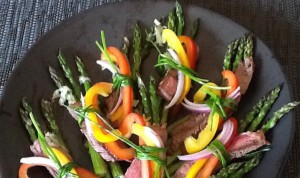
asparagus, sirloin, peppers, bermuda onion with a chive tie and parmesan for our Edge Center Art Gallery fund raiser. 125 of these little guys
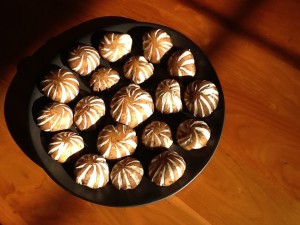
I’ve practiced silly, 1960’s vegetables from Julia:
And compulsively worked on the greatest Lyonnaise baguette taste, texture, crumb, with American flours and 48 varieties of liquid levains. We’re getting close.
I’ve make countless versions of boeuf bourguignon and its cousin, chicken fricassee. They’re glorious and are in little individual packets in the freezer. I’ve discovered that it’s crucially important to use grain-fed beef (chuck or tri-tip) and non-hormone-fed chicken for these. The others just don’t brown properly and taste nasty in comparison.
Here is a row of elegant salads (greens with vinaigrette, pear and almonds) that our wonderful group of Minnesota cooks did for their graduation dinner. 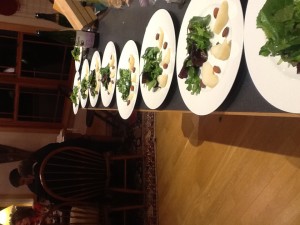
Then, just to Be Prepared, I learned to use a pastry bag in January, since I haven’t been much of a dessert person. Here’s one over-the-top version (okay, more like Princess Diana’s wedding dress, but one goes berserk with good pastry bag tips.)
The chocolate cake, raspberries, tempered chocolate shards and raspberry coulis at the top might look French. I’m thinking so. And also the chocolate gateau at the bottom, courtesy of David Lebowitz (The Sweet Life in Paris, FABULOUS book) is more French. My 10 year old friend Kate, who has an incredible feel for cooking and I did this, so we did not only made marzipan roses on a very french chocolate gateau, but also marzipan mice).
I’m ready to go learn from the guys who really know how to do it, I think.
In need of a sabbatical…
I’ve been working too hard for too long – 300 speaking engagements (2/3rd of them on planes) and 4 books in 3 years. Like that. And much as I love the work I get to do, I realized a couple of years ago that I’m burned to a crisp and need to take a break. I kept working and loving it, but I’m getting shrill. Two years ago I didn’t even know what a break might look like. The only thing I had the energy to imagine was kayaking in northern Minnesota, then reading Jane Austen and eating bonbons.
But after talking with friends and thinking a bit, something of the old me, the high school me, started to wake up. I wanted to do something that wasn’t motivated by Duty. Something that wouldn’t help anyone in particular. I bought Rosetta Stone and started to learn my first French. And I loved it. I have a language ear. I’m like a parrot. And in the last two years I’ve read 30 books in French, done immersion weeks at Concordia Language Villages (a wonderful place), and have listened to at least 10 audio books. Given the fact that I’m old enough and bossy enough to do what I want with my fun, there’s no one in the world who can make me read Camus or Sartre again. So I’ve read Agatha Christie and Sherlock Holmes and all the Harry Potter books in French. I’m fluent in mysteries. I know the French words for all the Quiddich vocabulary, “wand” (baguette magic), and “flesh-eating-slug.” I’m multi-tasking in escapism.
In the last two years, I’ve gotten to the point of real danger in a foreign language. As my brilliant French filmmaker friend said, “you don’t have any right to sound that good. You don’t know anything.” My accent is now good enough that I’ll probably sound as if I intended to say that awful thing I just accidentally perpetrated.
Here’s what I’ve learned as I’ve done this French thing hours each day: I don’t seem to be built to relax. But I can change obsessions. So in order to wean myself off of 50-70 hours a week of work (okay, I’ll be public about this. Our website is www.GraceNet.info) I shifted the overdrive into French.
Last February my husband broached the idea of walking the Camino of Santiago of Compostela (530 miles across the north of Spain with a backpack, and I’m just not going to go into the bedbug thing). I murmured a gentle “non, merci, my love” to his kind invitation and as we talked, the idea hit. Why not cook in Paris while he’s walking???
So I’m going to. I’ve done applications on a level of complexity akin to Princeton’s. I’ve honed my baguettes & croissants & stuffed, roasted chickens & sauces, and practiced les desserts over the last year. I’m heading off for three months of cooking in France this Friday – three months of cooking with some of the most amazing chefs’ teams in France (L’Institut Paul Bocuse, L’Ecole Alain Ducasse, Le Cordon Bleu, Lyon, Paris, the Loire Valley and in Quimper in Brittany). In French. On January 24th, I used some of my zillion frequent flyer miles to run up to Chicago, clutching 55 pages of “dossier” to my bosom, had my interview in French. The Consultat de France in Chicago gave me a visa to stay 93 days in France.
Look: they punched my ticket. I now have a big league French visa stapled onto page 8 of my passport.
I filed my last research report on February 7th. This afternoon, I started packing my one carry on bag. I’m trying to save room for 5 pounds of Bob’s Red Mill organic flour to give to the boulanger (baker) in Lyon who showed me how he does the best baguettes I’ve ever tasted. Also some wild rice. My friend Judy, who lives in Brittany, assures me that there are stores in France. I got a new credit card that doesn’t hit me up for 3% to buy toothbrushes and scarves in Europe. I’ll take two black outfits, two pairs of shoes, my French makeup, my Kindle, my iPad, my computer and 4 bottles of vitamins. That ought to pretty much cover it.
Even writing this makes if feel as if it’s going to happen. Thank you. It helps to talk about it. If you’re interested, stay tuned!




